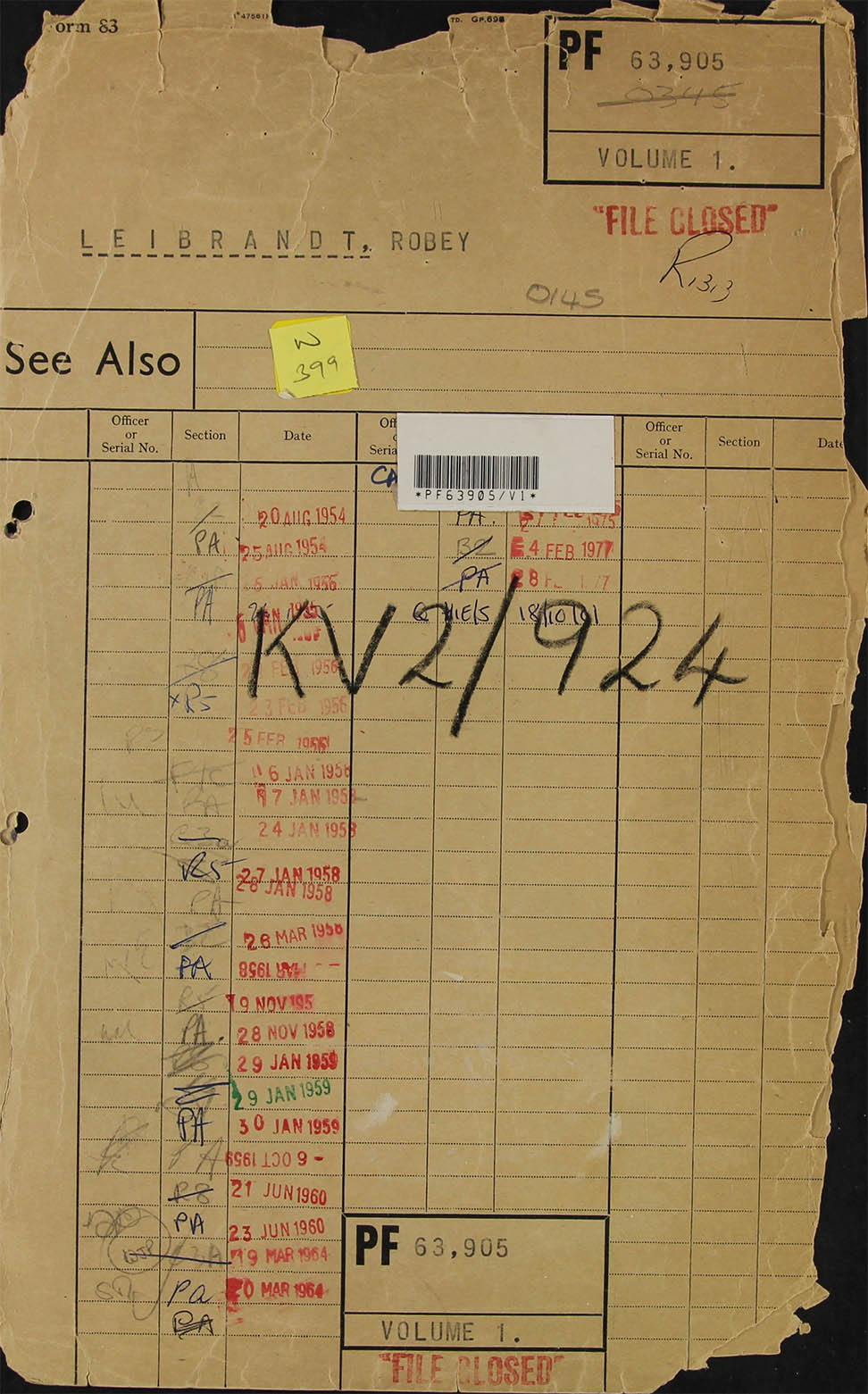
Page initiated 11 January 2022
Status: 17 January 2022
AOB: please notice - that this content is meant for studying purposes only; therefore do not multiply its content, as some is still due to Crown Copyright.
As an introduction: please consider, at your choice, the according Wikipedia preliminary information
English Language - Wikipedia version: https://en.wikipedia.org/wiki/Robey_Leibbrandt
German language - Wikipedia version: https://de.wikipedia.org/wiki/Robey_Leibbrandt
AOB: We must consider the British way of spelling Leibbrandt must be considered being incorrect, as the south Africans consequently spell his name as: Leibrandt.
Leibrandt was born on 25th January 1913, at Potchefstroom in Transvaal; South Africa (SA)
His father was of German descent and his mother was Irish
Chapter 1 (14 January 2022)
Chapter 2 (17 January 2022)
Chapter 3 (18 January 2022) File closure
This time, my main aim is to follow the course of reference in such a way, that the readers can themselves create the actual picture in which the events once took place.
The story enrols itself during the course of events/ circumstances, according the British Secret Service file series KV 2/924 and KV 2/925.
The aim of this contribution, is, to confront the readers, with some of the actual circumstances in South Africa during 1941 ... 1943

Crown Copyright
KV 2/924
Robey Leibrandt (South Africa)
PF63905
KV 2/924-1, page 7 (minute 46a) Press cut from Daily Sketch
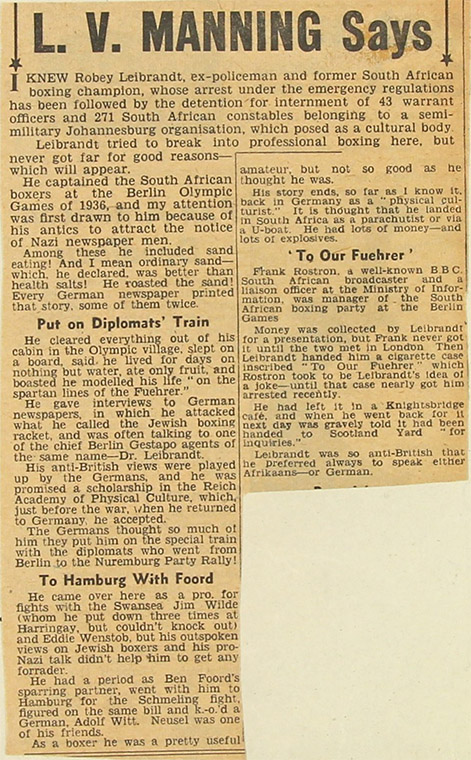
Crown Copyright
L.V. Manning Says
I knew Robey Leibrandt ex-policeman and former South African boxing champion, whose arrest under the emergency regulations has been followed by the detention for internment of 43 warrant officers and 271 South African constables belonging to a semi-military Johannesburg organisation, which posed as a cultural body.
Leibrandt tried to break into professional boxing here, but never got far for good reasons - which will appear.
He captained the South African boxers at the Berlin Olympic Games of 1936m and my attention was first drawn to him because of his antics to attract the notice of Nazi newspaper men.
Among these he included sand eating! And I mean ordinary sand - which he declared was better than health salts. He roasted the sand! Every German newspaper printed that story some of them twice.
Put on Diplomats' Train.
He cleared everything out of his cabin in the Olympic village slept on a board said, he lived for days on nothing but water ate only fruit and boasted he modelled his life "on the spartan lined of the Fuehrer".
He gave interviews to German newspapers, in which he attacked what he called the Jewish boxing racket, and was often talking one of the chief Berlin Gestapo agents of the same name - Dr, Leibrandt.
His anti-British views were played up by the Germans, and he was promised a scholarship in the Reich Academy of Physical Culture, which just before the war, when he returned to Germany he accepted.
The Germans thought so much of him they put him on the special train with the diplomats who went from Berlin to the Nuremburg (Nürnberg) party Rally!
To Hamburg With Foord.
He came over here (England) as a pro. for fights with the Swansea Jim Wilde (whom he put down three times at Harringay, but couldn't knock out.) and Eddy Wenstob, but his outspoken views on Jewish boxers and his pro-Nazi talk didn't help him to get any forrader.
He had a period as Ben Foord's sparring partner, went with him to Hamburg for the (Max) Schmeling fight, figured on the same bill and k-o'd a German Adolf Witt. Neusel was one of his friends.
As a boxer he was pretty useful amateur, but not so good as he thought he was.
His story end, so far I know it, back in Germany as a "physical culturist". It is thought that he landed in South Africa as a parachutist or via a U-boat (he actually was brought in by means of a small sailing boat called Kyloe*) He had lots of money - and lots of explosives.
'To Our Fueher'
Frank Rostron, a well-known B.B.C. South African broadcaster and a liaison officer at the Ministry of Information was manager of the South African boxing party at the Berlin Games.
Money was collected by Leibrandt for a presentation, but Frank never got it until the two met in London. Then Leibrandt handed him a cigarette case inscribed "To Our Fuehrer" which Rostron took to be Leibrandt's idea of a joke-until that case nearly got him arrested recently.
He had left it in a Knightsbridge café, and when he went back for it next day was gravely told it had been handed to Scotland Yard "for inquiries".
Leibrandt was so anti-British that he preferred always to speak either Afrikaans-or German.
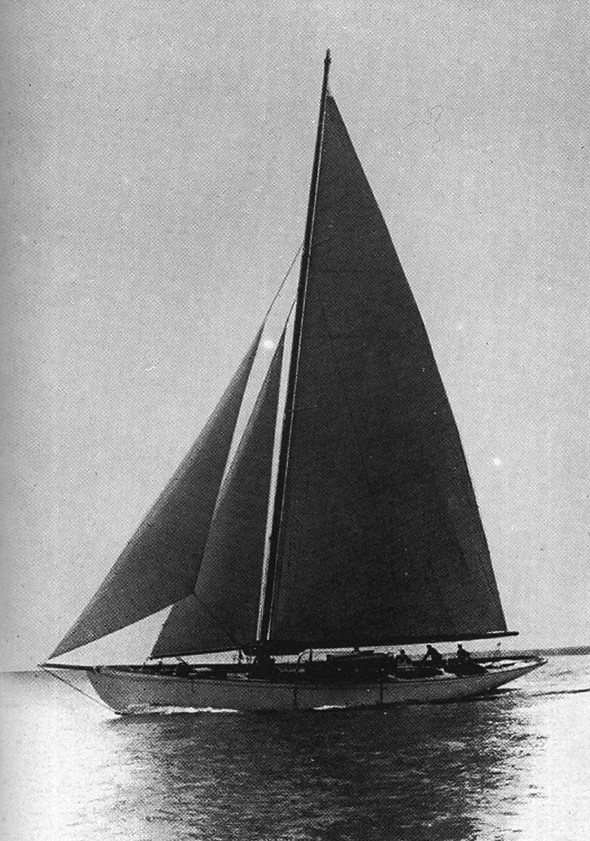
* (return-page-29) The Kyloe, managed by the German Abwehr, dropped Robey Leibrandt, with his quite some luggage, somewhere just off the South-African cost
KV 2/924-1, page 8 (minute 45a) Press cutting from "The Times"
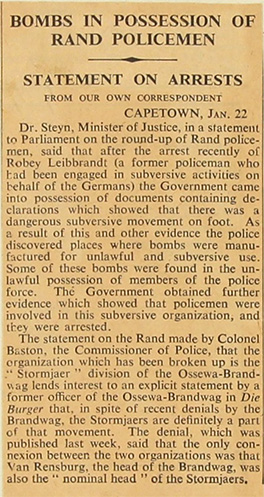
Crown Copyright
Bombs in Possession of Rand Policemen
Statement on Arrest
From our own correspondent
From Our Own Correspondent
Capetown, Jan. 22 (1942)
Dr. Steyn, Minister of Justice, in a statement to Parliament on the round-up of Rand policemen, said that after the arrest recently of Robey Leibrandt (a former policeman who had been engaged in subversive activities on behalf of the Germans) the Government came into possession of documents containing declarations which showed that there was a dangerous subversive movement on foot. As a result of this and other evidence the police discovered places where where bombs were manufactured for unlawful and subversive use. Some of these bombs were found in the unlawful possession of members of the police force. The Government obtained further evidence which showed that policemen were involved in this subversive organization, and they were arrested.
The statement on the Rand made by Colonel Baston, the Commissioner of Police, that the organization which has been broken up is the "Stormjaer" division of the Ossewa-Brandwag lends interest to an explicit statement by a former officer of the Ossewa-Brandwag in Die Burger that, in spite of recent denials by the Brandwag, the Stormjaers are definitely a part of that movement. The denial, which was published last week, said that the only connection between the two organisations was that Van Rensburg, the head of the Brandwag, was also the "nominal head" of the Stormjaers.
KV 2/924-1, page 10 (minute 43a) Press Cut from: Daily Mail, 22 Jan. 1942

Crown Copyright
South African Police Purge
Fifth Column Men had Bombs.
From Daily Mail Correspondent
Capetown, Wednesday.
The existence of a dangerous subversive movement was revealed by documents found after the arrest of robey Leibrandt ex-policeman and former boxing champion of South Africa. This led to the arrests of police involved in the movement at Witwaterrand.
Dr. Colin Steyn, Minister of Justice, stated this in the House of Assembly today in reply to the question from Dr. D. Malan, Opposition leader.
The evidence found after Leibrandt's arrest and other clues followed led the police to places where bombs were being manufactured for awful and subversive purposes. Even some of the arrested policemen were found to be in unlawful possession of bombs.
Dr. Malan asked for an assurance that the policemen would be tried in open court. Dr. Steyn said they were arrested under the emergency regulations and would be dealt with under the terms of the regulations.
349 Police Arrested.
Colonel G.R.C. Baston, police commissioner, stated at the Pretoria press conference today that 43 warrant officers and N.C.O.'s and 271 constable of the south African Police Force had been arrested in Johannesburg yesterday for internment.
A further 17 N.C.O.s and 18 constables, previously detained, were being held pending the investigation of allegations of high treason.
Bombs and firearms had been confiscated and documents seized. These showed that the men belonged to a semi-military organisation.
There was ample evidence that they were members of a stormtroop division of the Ossewabrandwag movement (South Africa's Nazi movement).
.....
AOB: please always bear in mind - that with increasing PDF page numbers, that you are going backwards in time.
KV 2/924-1, page 25 (minute 30a)
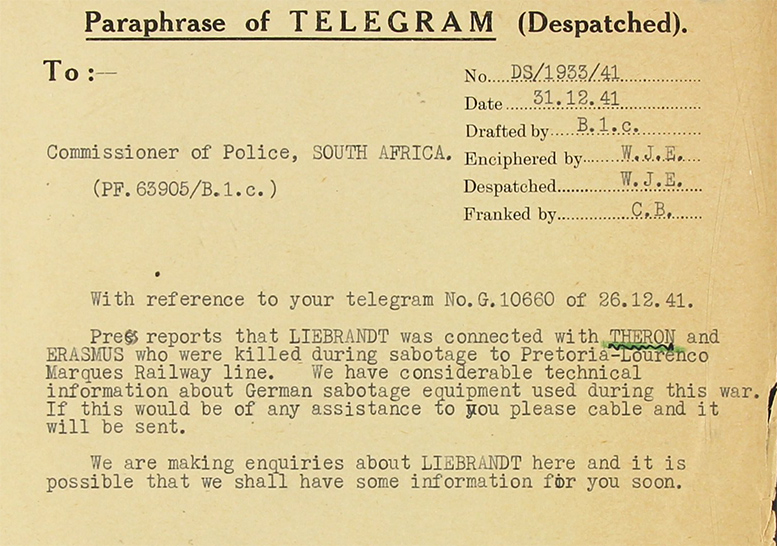
Crown Copyright
Paraphrase of Telegram (despatched)
To: - No. DS/1933/41
Date 31.12.41
Drafted by B.1.c. (M.1.5.)
Commissioner of Police, South Africa Enciphered by W.J.E.
PF. 93905 (Leibrandt's file reference)/B.1.c.) Despatched, W.J.E.
With reference to your telegram No. G. 10660 of 26.12.41.
Press reports that Leibrandt was connected with Theron and Erasmus who were killed during sabotage to Pretoria-Lourenco Marques Railway line. We have considerable technical information about German sabotage equipment used during this war. If this would be of any assistance to you please cable and it will be sent.
We are making enquiries about Leibrandt here and it is possible that we shall have some information for you soon.
KV 2/924-1, page 26 (minute 29a)
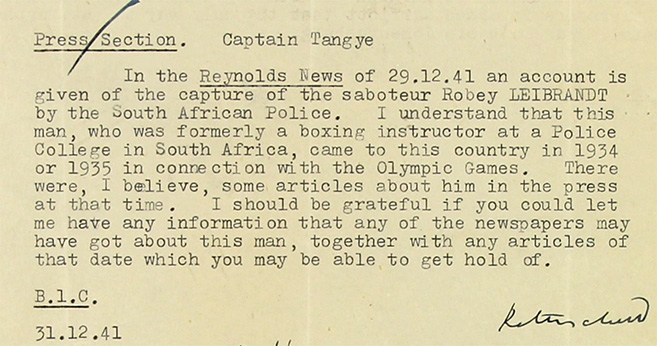
Crown Copyright
Press Section. Captain Tangye
In the Reynolds News of 29.12.41 an account is given of the capture of the saboteur Robey Leibrandt by the South African Police. I understand that this man, who was formerly a boxing instructor at a Police College in South Africa, came to this country (England) in 1934 (maybe during the Empire Games) or 1935 (not yet likely, but 1936) in connection with the Olympic Games (mid 1936). in connection with the Olympic Games. There were, I believe, some articles about him in the press at that time. I should be grateful if you could let me have any information that any of the newspapers may have got about this man, together with any articles of that date which you may be able to get hold of.
B.1.c (M.I.5) 31.12.41. Sgd. by Sir Rothschild
KV 2/924-1, page 29 (minute 27a) Press cutting Reynolds 29.12.41

Crown Copyright
News police Capture South Africa's
Gang Chief
Robey Leibrandt, the saboteur gang chief, who boasted that the police would not capture him alive, was arrested yesterday while travelling by car to Johannesburg and before he was able to draw his revolver.
Leibrandt is believed to been associated with the gang responsible for the bomb explosion on the Johannesburg-Lourenco Marques railway line on December 14th (1941).
Sabotage Attempt.
Leibrandt former South African heavy-weight boxing champion, re-entered the country mysteriously from abroad a few months ago (*) (return-page-29).
The sabotage attempt, in which two of his associates were killed, was the latest of a series of dynamite outrages in the Transvaal. They had previously been directed mainly against Jewish shops.
KV 2/924-1, page 39 (minute 19a)
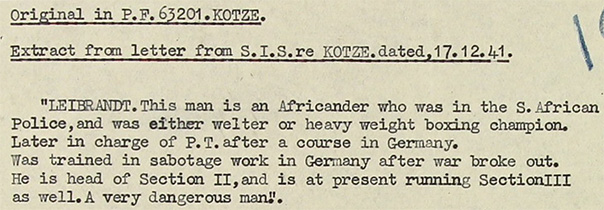
Crown Copyright
Extract in PF 63210 Kotze. (KV 2/1134 .. KV 2/1136) (Springbok, alias Huges: German. Springbok emigrated to Southern Africa in 1929, on the outbreak of the war he voluntary returned to Germany where he ...
Extract from letter from S.I.S. re Kotze dated, 17.12.41
"Leibrandt. This man is an Africander (Afrikaner) who was in the S. African Police, and was either welter or heavy weight boxing champion. Later in charge of P.T. after a course in Germany.
Was trained in sabotage work in Germany after was broke out. He is head of (German) Section II (sabotage), and is at present running Section III (??) (counter intelligence) as well. A very dangerous man".
KV 2/924-1, page 40 (minute 18b)

Crown Copyright
Extract from union of South Africa intelligence Summary
No. 17 dated 15.12.41.
Subversive activities:
Chief actor on the subversive stage in this country (South Africa) at the moment is Robey Leibrandt, some whose latest exploits are detailed in subsequent paragraphs of this Report. Leibrandt is still believed by the police to be hiding somewhere outside Pretoria, probably in the Brits-Nylstroom area. Both members of his "bodyguard" - D.K. Theron and Hendrik Erasmus - are dead. Erasmus was shot by the police and Theron was blown to pieces when a bomb he and "Doors" Erasmus were placing on the Pretoria-Premier Mine railway line exploded prematurely on the night of 14th December. "Doors" was a younger brother of Hendrik; he too, was killed. A third man escaped in a motor-car.
This dastardly attempt to blow up the line and to involve an oncoming? troop train in disaster has proved the culminating point in a series of minor dynamite and fire outrages which have taken place in various parts of the Transvaal recently. The sternest repressive measure are now to be taken by the Government to stamp out this recurrence of terrorism and there is talk of the death penalty being passed on saboteurs (British perspective).
A happy portent ? for the government was the result of the Newcastle parliamentary by-election when the Malanite candidate, Professor A.E. du Toit, was soundly beaten at the poll by Mr. R.B. Robertson, the United party man.
KV 2/924-1, page 41
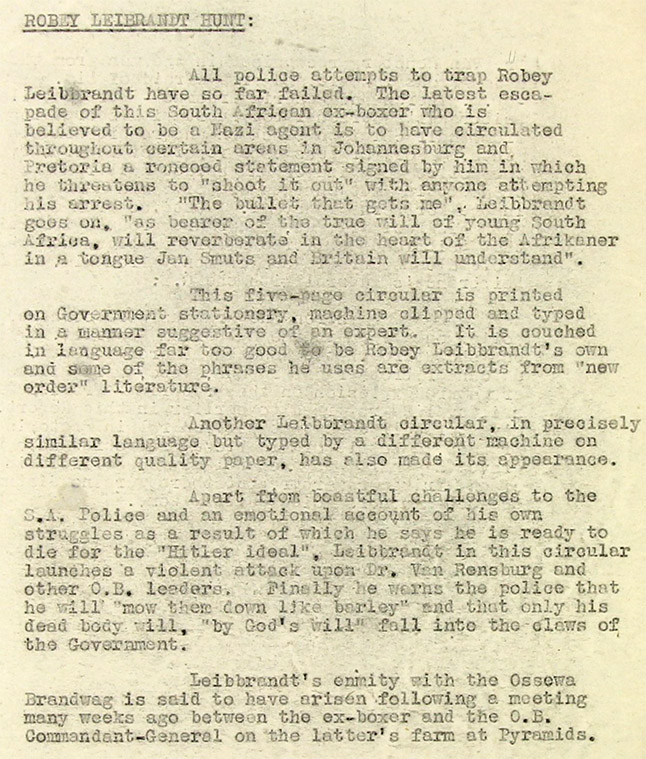
Crown Copyright
Robey Leibrandt Hunt:
All police attempts to trap Robey Leibrandt have so far failed. The latest escape of this South African ex-boxer who is believed to be Nazi agent is to have circulated throughout certain areas in Johannesburg and Pretoria a reneoed?? statement signed by him in which he threatens to "shoot it out" with anyone attempting his arrest. "The bullet that gets me", Leibrandt goes on, "as bearer of the true heart of the Afrikaner in a tongue Jan Smuts and Britain will understand".
This five-page circular is printed on Government stationary, machine slipped and typed in a manner suggestive of an expert. It is couched in language far to good to be Robey Leibrandt's own and some of the phrases he uses are extracts from "new order" literature.
Another Leibrandt circular, in precisely similar language but typed by a different machine on different quality paper, has also made its appearance.
Apart from boastful challenges to the S.A. (South African) Police and an emotional account of his own struggles as a result of which he says he is ready to die for the "Hitler ideal", Leibrandt in this circular launches a violent attack upon Dr. van Rensburg and other O.B. (Ossewa Brandwag) leaders. Finally he warns the police that he will "mow them down like barley" and that only his dead body will, "by God's will" fall into the claws of the Government.
Leibrandt's enmity with the Ossewa Brandwag is said to have arisen following a meeting many weeks ago between the ex-boxer (Robey Leibrandt) and the O.B. Commandant-General on the latter's farm at Pyramids.
KV 2/924-1, page 42
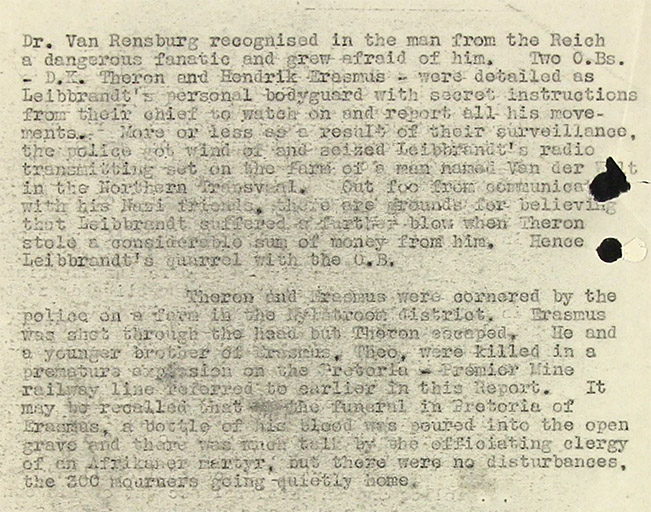
Crown Copyright
Dr. van Rensburg recognised in the man from the Reich (Hitler Germany) a dangerous fanatic and grew afraid of him. Two O.Bs. - D.K. Theron and Hendrik Erasmus - were detailed as Leibrandt's personal bodyguard with secret instructions from their chief (van Rensburg) to watch on and report all his movements. More or less as a result of their surveillance, the police got wind of and seized Leibrandt's radio transmitting set on the farm of a man named Wilt? Wolt?? in the Northern Transvaal. Out foe? from communication with the Nazi friends, there are grounds for believing that Leibrandt suffered a? further blow when Theron stole a considerable sum of money from him. Hence Leibrandt's quarrel with the O.B.
Theron and Erasmus were concerned by the police on a farm in the Nylstroom district. Erasmus was shot the head but Theron escaped. He and a younger brother of Erasmus, Theo, were killed in a premature explosion on the Pretoria - Premier Mine railway line referred to earlier in this report. It may be recalled that funeral in Pretoria of Erasmus, a bottle of his blood was poured into the open grave and there was much talk by the officiating clergy of an Afrikaner martyr, but there were no disturbances, the 300 mourners going quietly home.
KV 2/924-1, page 43 + 44
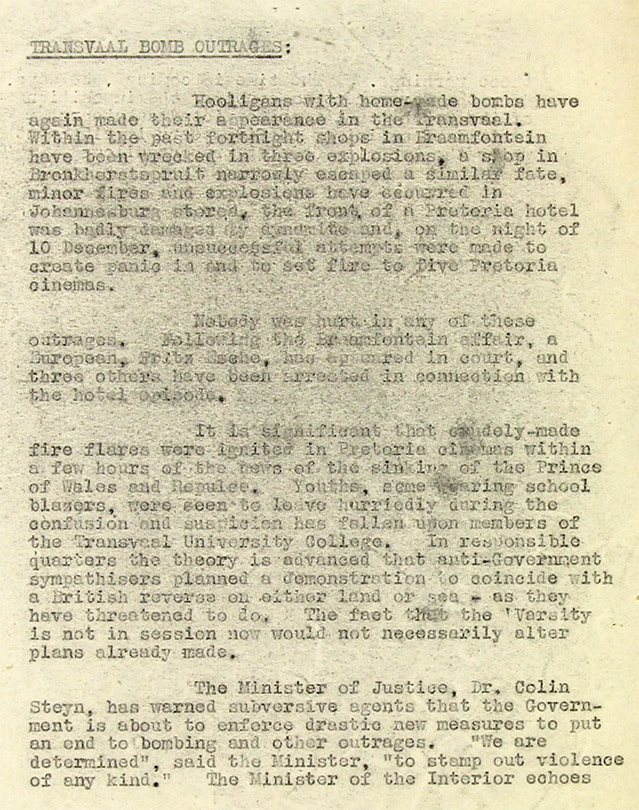

Crown Copyright
Transvaal Bomb Outrages:
Hooligans with home made bombs have again made their appearance in the Transvaal. Within the past fortnight shops in Braamfontein have been wrecked in three explosions, a shop in Bronkherstspruit? narrowly escaped a similar fate, minor fires and explosions have occurred? in Johannesburg sterea? the front of of a Pretoria hotel was badly damaged by dynamite and, on the night of 10 December (1941) unsuccessful attempt were made to create panic in and to set fire to five Pretoria cinemas.
Nobody was hurt in any of these outrages. Following the Braamfontein affair, a European, Fritz Esche, has appeared in the court, and three others have been arrested in connection with the hotel episode?
It is significant that the Gaudely-made?? fire flares were ignited in Pretoria cinemas within a few hours of the news of the sinking of the Prince of Wales and Repulse (by the Japs). Youths, some wearing school blazers, were seen to leave hurriedly during the confusion and suspicion has fallen upon members of the Transvaal University College. In responsible quarters the theory is advanced that anti-Government sympathisers planned a demonstration to coincide with a British reverse on either land or sea - as they have threatened to do. The fact that the "Varsity is not in session now would not necessarily alter plans already made.
AOB: Don't forget: - that Britain was, particularly in South Africa, considered often being an enemy of the Afrikaner population still, as the British aggression against the "Afrikaner" was still apparent in some minds.
First Boer War: https://en.wikipedia.org/wiki/First_Boer_War
Second Boer War: https://en.wikipedia.org/wiki/Second_Boer_War
Erster Boer Krieg: https://de.wikipedia.org/wiki/Erster_Burenkrieg
Zweiter Boer Krieg: https://de.wikipedia.org/wiki/Zweiter_Burenkrieg
Please consider the according Wikipedia links about the two Boer Wars; then you might realise - why quite many Afrikaner had serious resentment against Britain!
The Minister of Justice, Dr. Colin Steyn, has warned subversive agents that the Government is about to enforce drastic new measures to put an end to bombing and other outrages. "We are determined", said the Minister, "to stamp out violence of any kind". The Minister of the Interior echoes these warnings. "Time is coming", he says, "for the Government to consider the imposition of the death penalty on convicted saboteurs instead of a minimum of five years imprisonment which the Security Code at present allows".
KV 2/925-1, page 45 (minute 18b)
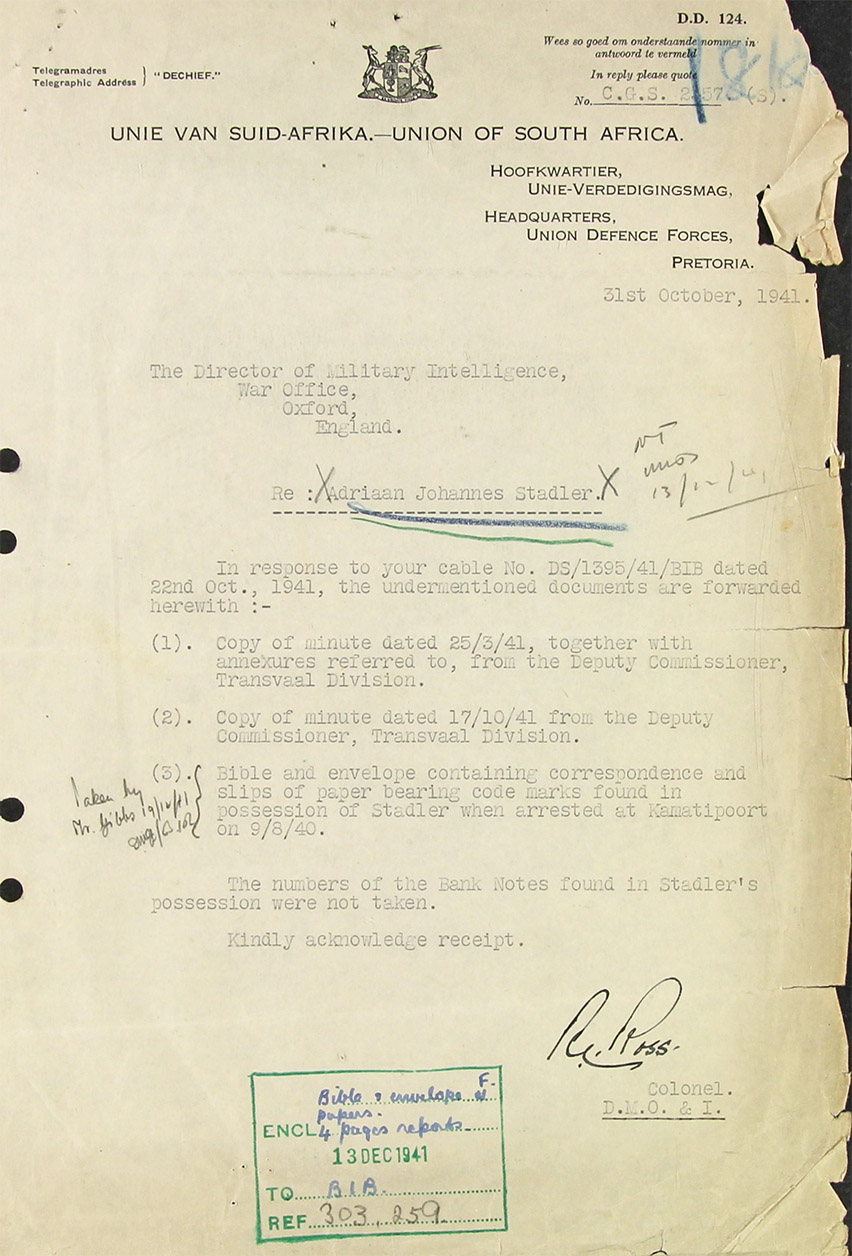
Crown Copyright
Unie van Suid-Afrika - Union of South Africa
Hoofdkwartier,
Unie-Verdedigingsmag,
Headquarters,
Union Defence Forces,
Pretoria.
31st October, 1941.
The Director of Military Intelligence,
War Office
Oxford,
England
Re: Adriaan Johannes Stadler.
In response to your cable No. DS/1395/41/B1B (M.I.5) dated 22nd Oct., 1941, the undermentioned documents are forwarded herewith: -
(1) Copy of minute dated 25/3/41, together with annexures referred to, from the deputy Commissioner, Transvaal Division.
(2) Copy of minute dated 17/10/41 from the Deputy Commissioner, Transvaal Division.
(3) Bible and envelope containing correspondence and slips of paper bearing code marks found in possession of Stadler when arrested at Kamatipoort on 9/8/40.
The numbers of the Bank Notes found in Stadler's possession were not taken. (British Secret Services were always rather keen in tracing the banknote movements)
Kindly acknowledge receipt,
Sgd. ? Ross
Colonel
D.M.O. & I.
KV 2/924-1, page 46 (minute 18a) My transcription, this time, reproduces the genuine Afrikaans language entirely
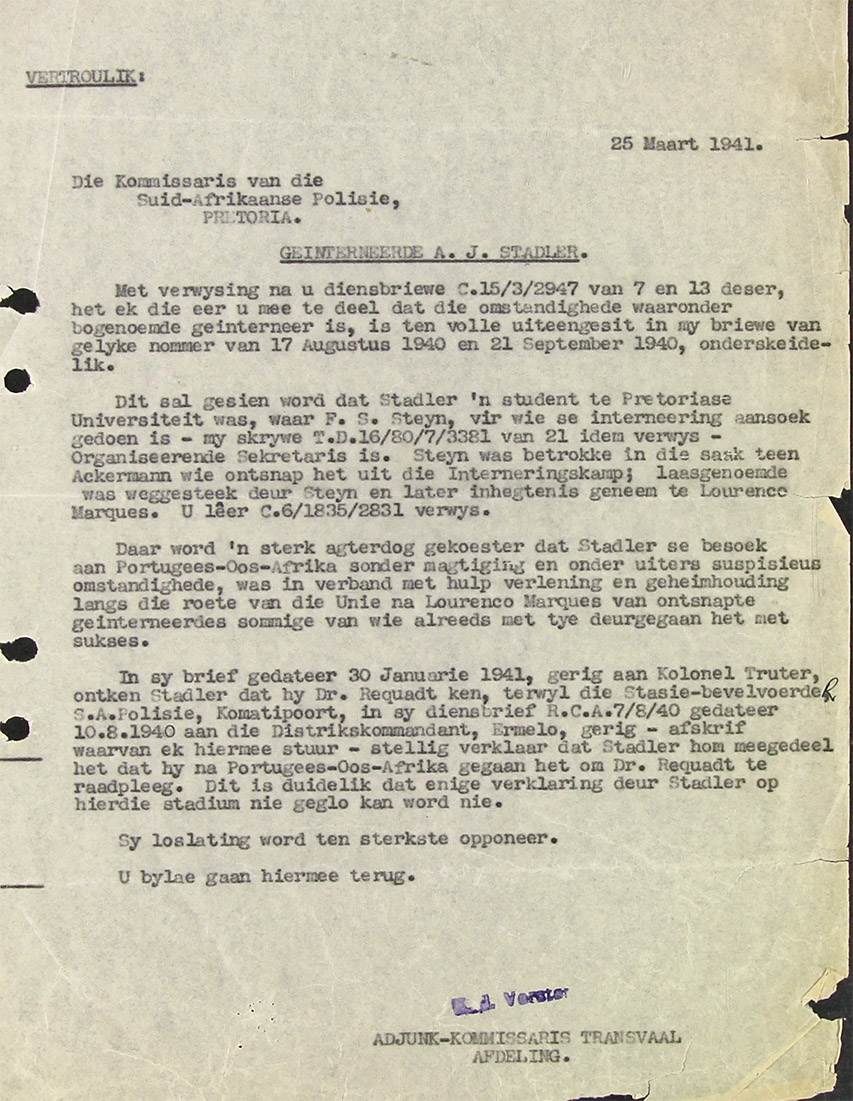
Crown Copyright
Vertroulik: (The Afrikaner language originated from 17th century Dutch language)
25 Maart 1941. (at this time Robey Leibrandt had not yet returned in South Africa again)
Die Kommissaris van die
Suid-Afrikaanse Polisie,
Pretoria.
Geinterneerde A.J. Stadler.
Met verwysing na u dienstbriewe C.15/3/2947 van 7 en 13 deser, het ek die eer u mee te deel dat die omstandihede waaronder bogenoemde geinterneer is, is ten volle uiteengesit in my briewe van gelyke nommer van 17 Augustus 1940 en 21 September 1940, onderskeidelik.
Dit sal gesien word dat Stadler 'n student to Pretoriase Universiteit was, waar F.S. Steyn, vir wie se interneering aansoek gedoen is - my skrywe T.D.16/7/3281 van 21 idem verwys - Organiseerende Sekretaris is. Steyn was betrokke in die saak teen Ackermann wie ontsnap het uit die Interneringskamp; laasgenoemde was weggesteek deur Steyn en later inhegtenis geneem te Lourenco Marques. U lêer C.6/1835/2831 verwys.
Daar word 'n sterk agterdog gekoester dat Stadler se besoek aan Portugees-Oos-Afrika sonder magtiging en onder uiters susposieus omstandighede, was in verband met hulp verlening en geheimhouding langs die roete van die Unie na Lourenco Marques van ontsnapte geinterneerdes sommige van wie alreeds met tye deurgegaan het met sukses.
In sy brief gedateer 30 Januarie 1941, gerig aan Kolonel Truter, ontken Stadler dat hy Dr. Requdt ken, terwyl die Stasie-bevelvoerder S.A. Polisie, Komatipoort, in sy dienstbrief R.C.A.7/8/40 gedateer 10.8.1940 aan die Distrikskommandant, Ermelo, gerig - afskrif waarvan ek hiermee stuur - stellig verklaar dat Stadler hom meegedeel het dat hy na Portugees-Oos-Afrika gegaan het om Dr. Requadt te raadpleeg/ Dit is duidelik dat enige verklaring deur Stadler op hierdie stadium nie geglo kan word nie.
Sy loslating word ten sterkste opponeer.
U bylae gaan hiermee terug.
K.d. Verster
Adjunk-Kommissaris Transvaal
Afdeling
KV 2/924-1, page 49 (minute 18a)

Crown Copyright
The Commissioner of the South African Police, Pretoria.
Re: Internment : A.J. Stadler.(notice: decarded 4 Apr. 1955; which means his indexed card had been removed, he was no longer a threat to England; dead or still alive)
Your file C15/3/2947 refers.
I have the honour to inform you that Adriaan Johannes Stadler is a Union National by birth and parentage. He was born in Sutherland, Cape Province, and is 24 years of age. At the age of 10 years he moved with his parents to Gobabis, South West Africa, where the latter are still residing.
On 3rd November, 1940, Stadler was arrested and interned at Ganspan, under the National Emergency Regulations. At that time he was a student at the Pretoria University and as the final examination for his B.A. (Bachelor Administration) degree was at hand every endeavour was made to obtain his release. On 8th May, 1941, Stadler was unconditionally released from internment and he returned to the Pretoria University. Professor M.C. Botha, Rector of the Pretoria University, informed members of the Criminal Investigation Department that he himself urged Colonel Truter for the release of Stadler and that he vouched for Stadler's conduct.
On 7th instant a party of men went to the farm of the Rev. Joyce at Brits to arrest Robey Leibrandt for internment- file SAP.15/3/3761 refers. Leibrandt resisted arrest and whilst the men were busy with him, his companion was seen sneaking away. Leibrandt's car was searched and a suitcase containing Stadler's clothing was found in the car. The description of Leibrandt's companion furnished by the Rev. Joyce and his family is identical to that of Stadler.
Information was received through confidential sources that Leibrandt and Stadler are travelling together but that the latter was seriously wounded as a result of an affray they had in Louis Trichardt.
Enquiries were instituted at the Pretoria University and it was learned that Stadler has not been seen there fore the past 21 days. The mater was also discussed with the Rector, Professor Botham who states that he has been terribly let down" by Stadler and will not be responsible for his (Sadler's) future actions.
There is no doubt that the two persons mentioned are well armed and will under no circumstances submit arrest. In the above circumstances Stadler must be considered a danger to the safety of the State and his re-interment at Ganspan is strongly recommended.
The Control Officer agrees with my recommendation.
K.d. Verster
Deputy Commissioner
Commanding Transvaal Divisions.
(2) (17 January 2022)
KV 2/924-2, page 50 (minute 15a)
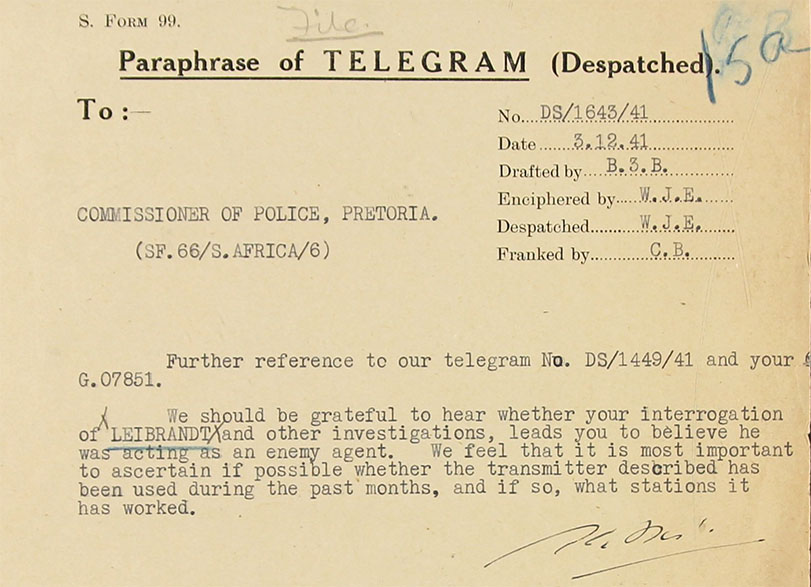
Crown Copyright
Paraphrase of Telegram (Despatched)
To: No. DS/1643/41
Date: 3.12.41
Drafted by B.3.b. (M.I.5)
Commissioner of Police, Pretoria
(S.F.66/S.Africa/6) (file reference)
Further reference to our telegram No. DS/1449/41 and your G.07851.
We should be grateful to hear whether your interrogation of Leibrandt and other investigations, leads you to believe he was acting as an enemy agent. We feel that it is most important to ascertain if possible whether the transmitter described has been used during the past months, and if so, what stations it has worked.
KV 2/924-2, page 51 (minute 14a)

Crown Copyright
B.1.a.(M.I.5.)
The following news item appeared in the daily Mail for the 20th October:-
"Capetown, Sunday. - An up-to-date wireless transmitter believed to have been used by Robert Leibrandt, former South African boxing champion, for whom the police are searching, has been discovered in Northern Transvaal.
The transmitter is of excellent quality and small enough to be portable. Leibrandt is armed and is apparently determined to resist arrest".
In reply to an enquiry, the following report was received from the Commissioner of Police, Pretoria:-
"We are unable to say whether transmitter used direct to enemy. (Make?) necessary arrangements to valve transmitter power pack crystal unit morse communication. Unit consists of 9 crystals (being sent?) 9 point switch can be plugged into transmitter. Frequencies 12285, 12270, 12359, 11282, 11272, 11256, 8556, 8539, 8523 kHz. 3 wave lengths in each 24, 26, 35 metre bands. 1 6L6 crystal stage driving 2 6L6 valves in parallel output 50 - 75 watts. Power pack 83 type rectifier. High voltage transformer usual (smoothing?) (joke) can be used on AC mains 110 and 240 (group undipherable) DC output over 500 volts. Transmitter and power pack not factory but good construction assembled by expert, some components are continental, valves American. (Sylvania) many parts no makers name unless mark. Test show capabilities under good condition up to 5/6,000 miles. Unable to give call-sign, preamble or code".
R.S.S. expressed the view that the frequencies and power employed would permit satisfactory communication with Germany during hours though it is unlikely that even North Africa could be worked during daylight. A further cable has now been despatched to the Commissioner of Police, Pretoria, in order to ascertain whether their further investigations lead the Police to believe that Leibrandt was acting as an enemy agent, and, also, whether there is any information to show what, if any, stations have been worked by the transmitter.
B.3.b. 2.12.41 Sgd. R.L. Hughes.
KV 2/924-2, page 52 (minute 14a)
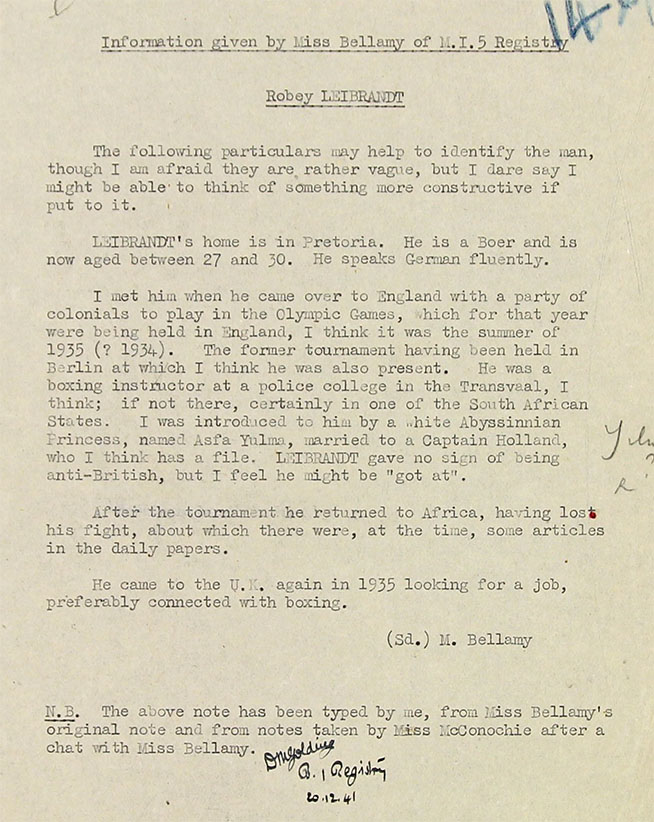
Crown Copyright
Information given by Miss Bellamy of M.I.5 Registry.
Robey Leibrandt.
The following particulars may help to identify the man, though I am afraid they are rather vague, but I dare say I might be able to think of something more constructive if put to it.
Leibrandt's home is in Pretoria. he is a Boer and is now aged between 27 and 30. he speaks Germany fluently.
I met him when he came over to England with a party of colonials to play in the
Olympic Gamers (Berlin 1936),
which for that year were being held in England, I think it was summer of 1935 (?1934).
The former tournament having been held in Berlin at which I think he was also
present. He was a boxing instructor at a police college in the Transvaal,
I think; if not there, certainly in one of the South African States. I was
introduced to him by a a white Abyssinian princess, named Asfa Yulma, married to
a Captain Holland, who I think was a file. Leibrandt gave no sign of being
anti-British, but I feel he might be "got at".
After the tournament he returned to Africa, having lost his flight, about which there were, at the time, some articles in the daily papers.
he came to the U.K. again in 1935 looking for a job, preferably connected with boxing.
Sgd. M. Bellamy
N.B. The above note has been typed by me, from Miss Bellamy's original note and from notes taken by Miss McConochie after a chat with Miss Bellamy.
KV 2/924-2, page 60 + 61 (minute 8a)
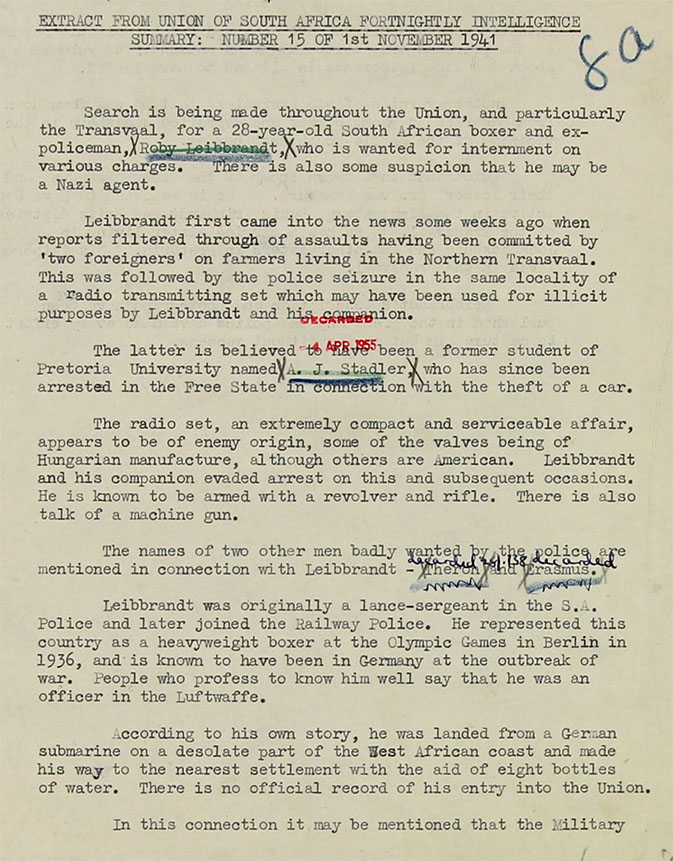
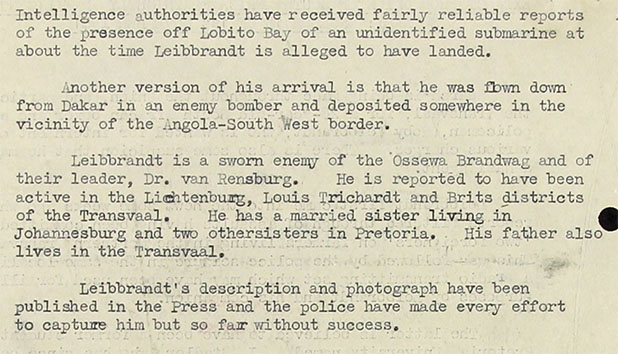
Crown Copyright
Extract from Union South Africa Fortnightly Intelligence Summary : Number 15 of 1st November 1941.
Search is being made throughout the Union, and particularly the Transvaal, for a 28 year-old South African boxer and ex-policeman, Robey Leibrandt, who is wanted for internment on various charges. There is also some suspicion that he may be a Nazi agnet.
Leibrandt first came into the news some weeks ago when reports filtered through of assaults having been committed by 'two foreigners' on farmers living in the Northern Transvaal. This was followed by the police seizure in the same locality of a radio transmitting set which may have been used for illicit purpose by Leibrandt and his companion.
The latter is believed to have been a former student of the Pretoria University named A.J. Stadler (decarded 4 Apr. 1955) (A bulk op documents of Stadler, are pointing at a fanatic Christian fate believer, I have, however, decided to skip them), who has since been arrested in the Free State in connection with the theft of a car.
The radio set, an extremely compact and serviceable affair, appears to be of enemy origin, some of the valves being of Hungarian manufacture (Tungsram) (https://de.wikipedia.org/wiki/Tungsram) manufacture, although others are American. Leibrandt and his companion evaded arrest on this and subsequent occasions. He is known too be armed with a revolver and rifle. There is also talk of a machine gun.
The names of two other men badly wanted by the police are mentioned in connection with Leibrandt Theron and Erasmus (both men were decarded, in the 1950s I suppose)
Leibrandt was originally a lance-sergeant in the S.A. (South African) Police and later joined the Railway Police. He represented this country as a heavyweight boxer at the Olympic Games in berlin, 1936, and is known to have been in Germany at the outbreak of war (Sept. 1939). People who profess to know him well say that he was an officer in the Luftwaffe (un-true!)
According to his won story, he was landed from a German submarine (nonsense!) See D11 D11-return. It concerned the smart usage of the Abwehr sailing ship Kyloe! on a desolate part of the West African coast and made his way to the nearest settlement with the aid if eight bottles of water. There is no official record of his entry into the Union.
In this connection it may be mentioned that the Military Intelligence authorities have received fairly reliable reports of the presence off Lobito Bay of an unidentified submarine at about the time Leibrandt is alleged to have landed.
Another version of his arrival is that he was flown down from Dakar in an enemy bomber and deposited somewhere in the vicinity of the Angola-South West border. (AOB, this fits more to a small booklet, but still omitting the application of a sailing boat)
Leibrandt is a sworn enemy of the Ossewa Brandwag and of their leader, Dr. van Rensburg. He is reported to have been active in the Lichtenburg, Louis Trichardt and British districts of Transvaal, He has married sister living in Johannesburg and two other sisters in Pretoria. His father also lives in Transvaal.
Leibrandt description and photograph have been published in the Press and the police have made every effort to capture him but so far without success.
KV 2/924-2, page 62 (minute 7a)
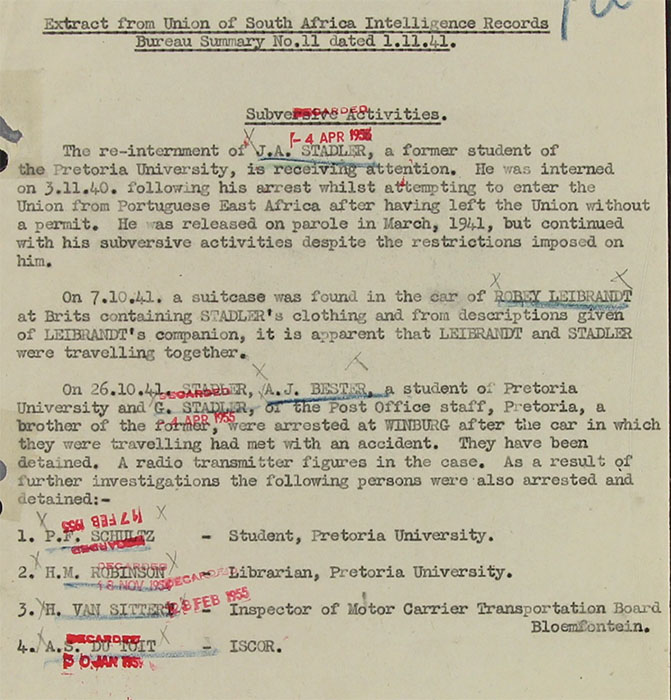
Crown Copyright
Extract from Union of south Africa Intelligence records Bureau summary No. 11 dated 1.11.41.
Subversive Activities.
The re-interment of J.A. Stadler, a former student of the Pretoria university, is receiving attention. He was interned on 3.11.40 following his arrest whilst attempting to enter the Union from Portuguese East Africa after having left the Union without a permit. He was released on parole in March 1941, but continued with his subversive activities despite the restrictions imposed on him.
On 7.10.41 Stadler, A.J. Bester, a student of Pretoria university and G Stadler of the Post Office staff, Pretoria, a brother of the former, were arrested at Winburg after the car in which they were travelling had met an accident. They have been detained. A radio transmitter figures in the case. As a result of further investigations the following persons were also arrested and detained: -
(all following had been decarded somewhere about Febr. 1955)
1. P.F. Schultz - Student, Pretoria University.
2. H.M. Robinson - Librarian, Pretoria University
3. H. van Sitters - Inspector of Motor Carrier Transportation Board Bloemfontein.
4. A.S. du Toit - Iscor
KV 2/924-2, page 63 (minute 6a)
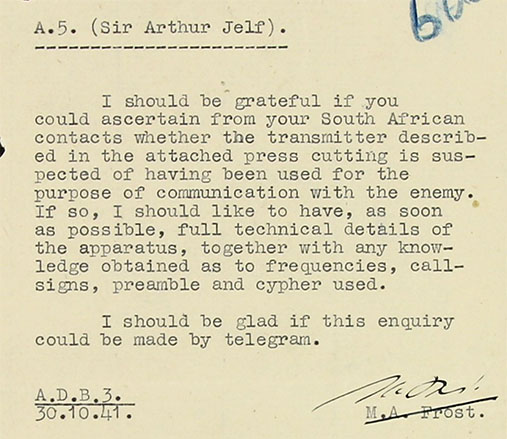
Crown Copyright
A.5. (Sir Arthur Jelf) (AOB, addressed onto, I suppose, the H.O.)
I should be grateful if you could ascertain from your South African contacts whether the transmitter described in the attached press cutting is suspected of having been used for the purpose of communication with the enemy. If so, I should like to have, as soon as possible, full technical details of the apparatus, together with any knowledge obtained as to frequencies, call-signs, preamble and cypher used.
I should be glad if this enquiry could be made by telegram.
A.D.B.3. (likely M.I.5.) 30.10.41 Sgd. M.A. Frost
KV 2/924-2, page 68 (minute 2a)
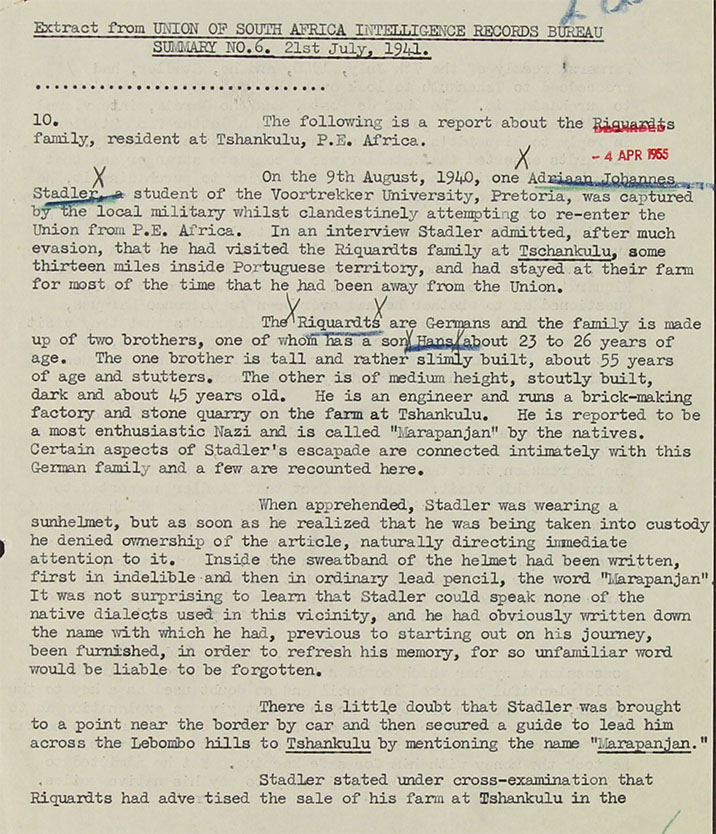
Crown Copyright
Extract from Union of South Africa intelligence records bureau Summary No 9, 21st July, 1941.
10. The following is a report about the Riquardts family, resident at Tskankulu, Portuguese East Africa.
On the 9th August, 1940 one Adriaan Johannes Stadler, student of the Voortrekker University, Pretoria, was captured by the local military whilst clandestinely attempting to re-enter the Union from P.E. Africa. In an interview Stadler admitted, after much evasion, that he had visited the Riquardts family at Tschankulu, some thirteen miles inside Portuguese territory, and had stayed at their farm for most of the time that he had been away from the union.
The Riquardts are Germans and the family is made up of two brothers, one of whom has a son Hans about 23 to 26 years of age and stutters. The other is of medium height, stoutly built, dark and about 45 years old. He is an engineer and runs a brick-making factory and stone quarry on the farm at Tshankulu. He is reported to be a most enthusiastic Nazi and is called "Marapanjan" by the natives. certain aspects of Stadler's escape are connected intimately with this German family and a few are recounted here.
When apprehended, Stadler was wearing a sunhelmet, but as soon as he realised that he was being taken into custody he denied ownership of the article, naturally directing immediate attention to it. Inside the sweatband of the helmet had been written, first in indelible and then in ordinary lead pencil the word "Marapanjan". It was not surprising to learn that Stadler could speak none of the native dialects used in this vicinity, and he had obviously written down the name with which he had, previously to starting out on his journey, been furnished, in order to refresh his memory, for so unfamiliar word would be liable to be forgotten.
There is little doubt that Stadler was brought to a point near the border by car and then secured a guide to lead him across the Lebombo hills to Tshankulu by mentioning the name "Marapanjan".
Stadler stated under cross-examination that Riquardts had advertised the sale of his farm at Tshankulu in the →(page 69)→ Farmer's weekly of 7th July, 1940, ..
KV 2.924-2, page 69
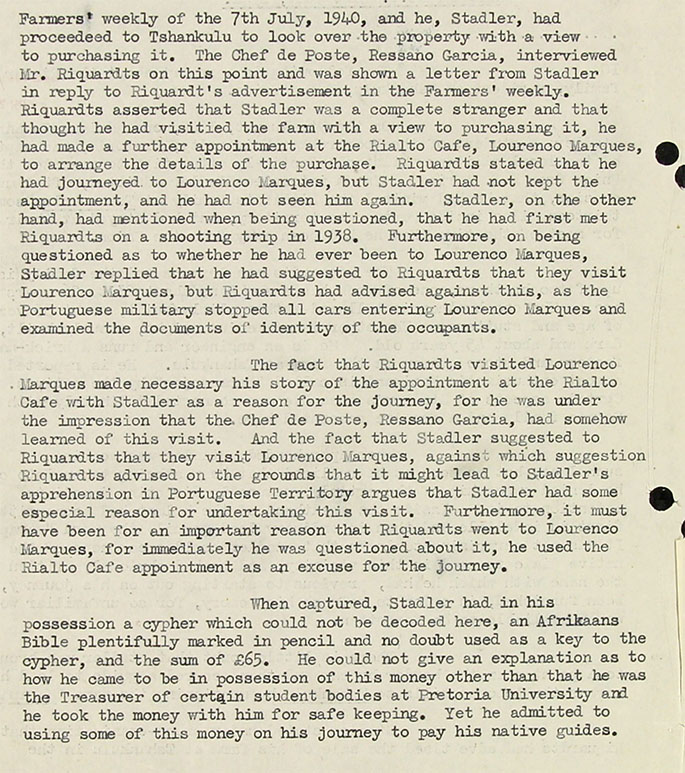
Crown Copyright
Farmer's weekly of 7th July, 1940, and he, Stadler, had proceeded to Tshankulu to look over the property with a view to purchasing it. The Chef de Poste, Ressano Garcia, interviewed Mr. Riquardts on this point and was shown a letter from Stadler in reply to Riquardt's advertisement in the Farmers' weekly. Riquardts asserted that Stadler was a complete stranger and that thought he had visited the farm with a view to purchasing it, he had made a further appointment at the Rialto Café, Lourenco Marques, to arrange the details of the purchase. Riquardts stated that he had journeyed to Lourenco Marques, but Stadler had not kept the appointment, and he had not seen him again. Stadler, on the other hand, had mentioned when being questioned, that he had first met Riquardts on a shooting trip in 1938. Furthermore, on being as to whether he had ever been to Lourenco Marques, Stadler replied that he had suggested to Riquardts that they visit Lourenco Marques, but Riquardts had advised against this, as the Portuguese military stopped all cars entering Laurenco Marques and examined the documents of identity of the occupants.
The fact that Riquardts visited Lourenco Marques made necessary his story of the appointment at the Rialto Café with Stadler as a reason for the journey, for he was under the impression that the Chef de Poste, Ressano Garcia, had somehow learned of his visit. And the fact that Stadler suggested to Riquardts advised on the grounds that it might lead to Stadler's apprehension (worry) in Portuguese Territory argues that Stadler had some especial reason for undertaking this visit. Furthermore, it must have been for an important reason that Riquardts went to Lourenco Marques, for immediately he was questioned about it, he used the Rialto Café appointment as an excuse for the journey.
When captured, Stadler had in his possession a cypher which could not be decoded here, an Afrikaans Bible plentifully (copiously) marked in pencil and no doubt used as a key to the cypher†, and a some of £65. He could not give an explanation as to how he came to be in possession of this money other than that he was the Treasurer of certain student bodies at Pretoria university and he took the money with him for safe keeping. yet he admitted to using some of his money on his journey to pay the native guides.
† KV 2/924-2, page 17

Crown Copyright
This schedule was among the materials captured when Stadler was arrested. It might point at a code-book instruction related to an Afrikaans Bible book chapter "Handelingen"; the best literature for an universal "one-time-path codes". Crucial is, that it only works as long at both ends of the line - being employed exactly the same book issue.
KV 2/924-2, page 70 (minute 2a)

Crown Copyright
Whether Stadler took out some information, useful to the enemy, which was communicated to the German Consulate in Lourenco Marques by Riquardts when he visited there and whether the sum of £65 found on Stadler was payment for this service, is a matter for the conjecture (speculation).
However, it is a fact that Riquardts has no intention of disposing of the farm at Tshankulu and anybody answering an advertisement connected with the sale, should be viewed with the utmost suspicion.
It is known that certain natives living in the Union (S.A.) on or near the border will lead anyone asking to be taken to Marapanjan, across the Lebombo hills.
Stadler was interned immediately after his arrest; he was however released, but placed under very strict Police control.
KV 2/924-2, page 73 (minute 1r)

Crown Copyright
Press cutting of "The Star" 18.10.41
Nazi Radio seized
Police visiting a farm in Northern Transvaal have seized a radio transmitter of German origin.
Two brothers on whose farm it was found have been arrested and interned, says Exchange.

Crown Copyright
KV 2/925-1
Leibrandt Robey
PF 63905
AOB: please consider the "jacket" which started to be worked upon - on 20th January 1958
Bear always in mind - that the KV 2/xxxx serials originate from the 1950s, before it all was collected under the PF 63.905 serials (Volume xx)
KV 2/925-1, page 2 An example of the Minute Sheet

Crown Copyright
29.1.42 B.5 (M.I.5) note re Leibrandt contacts in this country (England) (50a)
30.1.42 Press Cuttings re the Rand Sabotage. (51a)
31.1.42 A.D.B.1 (M.I.5. Mr. D.G. Whight) (52a)
..
24.2.42 Memo from A.D.B.1. to B.1.b. (both internal M.I.5.) (56a)
...
22.3.42 Cutting from Sunday times re South African Trial. (59a)
KV 2/925-1, page 3
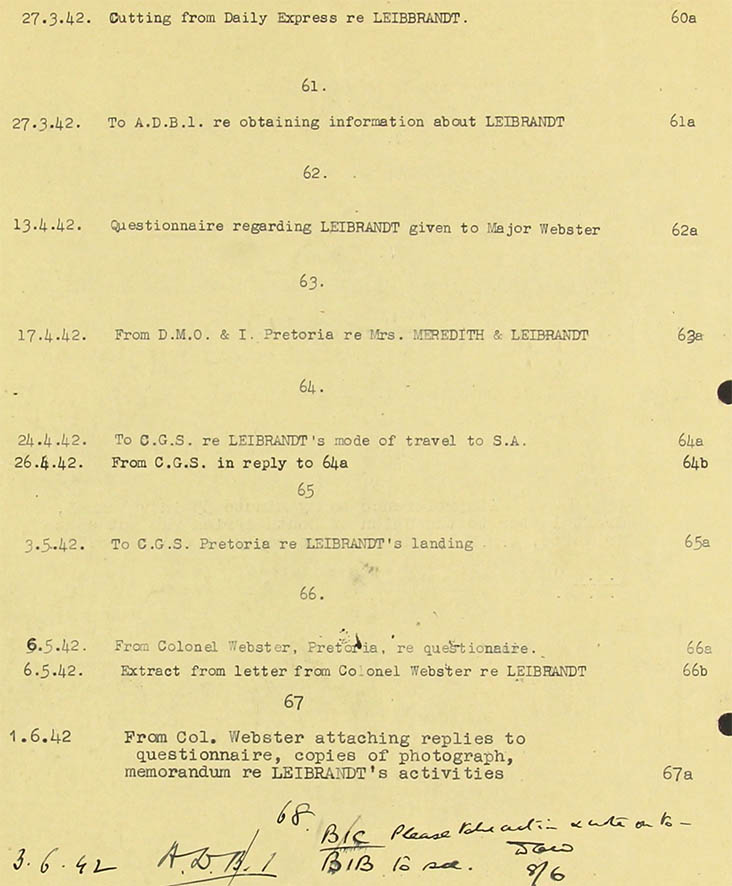
Crown Copyright
3.5.42 To C.G.S. Pretoria Leibrandt's landing (65a)
...
KV 2/925-1, page 4

Crown Copyright
A.D.B.1. (M.I.5.) Mr. D.G. White
..
..
Leibrandt refused to answer any of the questions in our questionnaire which are of interest. I think he must be one of the most important agents caught so far this war, having had, we believe, an extensive training at Abteilung II (sabotage) headquarters, and having apparently a big job to do rather on Goertz's lines, in South Africa. If he were found guilty by South Africa Courts, would there be any chance of getting him over here for questioning? He must be a mine of information if only he were dealt with in the right way. (in vain)
B.1.c. (M.I.5.) 11.6.42
..
KV 2/925-1, page 7
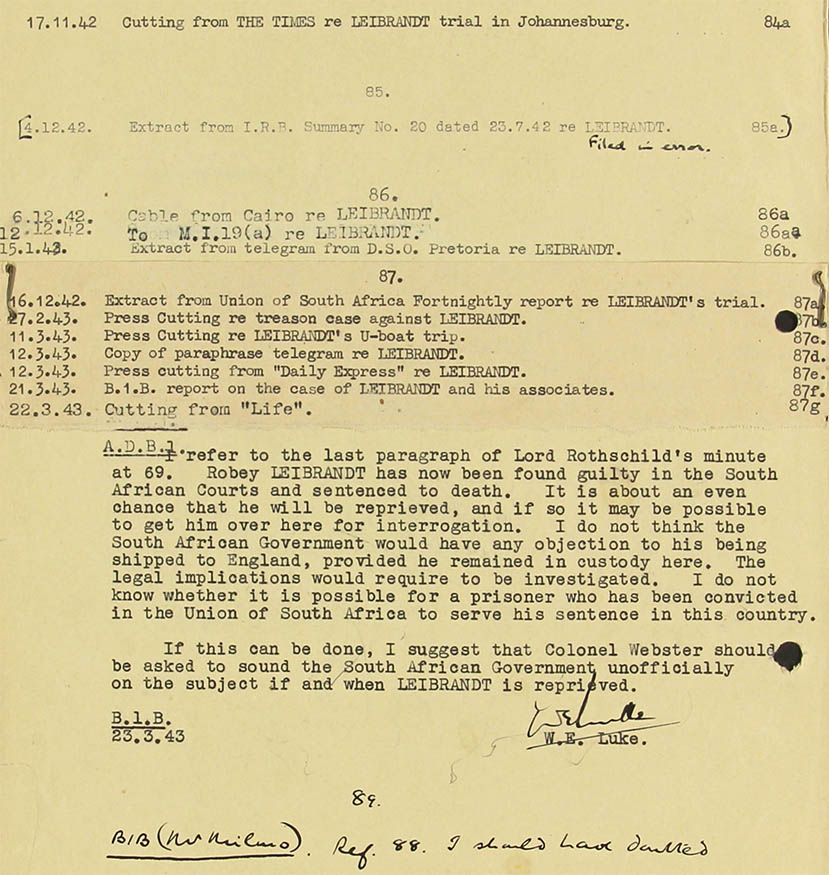
Crown Copyright
17.11.42 Cutting from the Times re Leibrandt trial in Johannesburg (84a)
..
..
A.D.B.1 (Mr. Dick G. White)
I refer to the last paragraph of Lord Rothschild (whom is particularly concerned with sabotage means) minute at (69a) Robey Leibrandt has now been found guilty in the South African Courts and sentenced to death (he will not be executed and he came free in 1948). It is about an even chance that we will be reprieved (pardoned), and if so it may be possible to get him over here for interrogation (which will not happen). I do not think the South African Government would have any objection to this being shipped to England, provided he remained in custody here (a typical way of short-mind thinking, neglecting the "anti-British" sentiments in South Africa; typically minds not understanding the negative impact of Britain in quite many (also former) colonies). The legal implications would require to be investigated. I do not know whether it is possible for a prisoner who has been convicted in the Union of south Africa to serve his sentence in this country.
If this can be done, I suggest that Colonel Webster should be asked to sound the South African Government unofficially on the subject if and when Leibrandt is reprieved.
B.1.b. 23.3.43 Sgd. W.E. Luke (Major)
AOB: Leibrandt will be convicted to death, but it was considered that this sentence might upset too many Afrikaner, that it was practically changed in Life-sentence. However, in 1948, in a kind of 'amnesty' he and others were released and set free.
KV 2/925-1, page 9 (in particular minute 90)
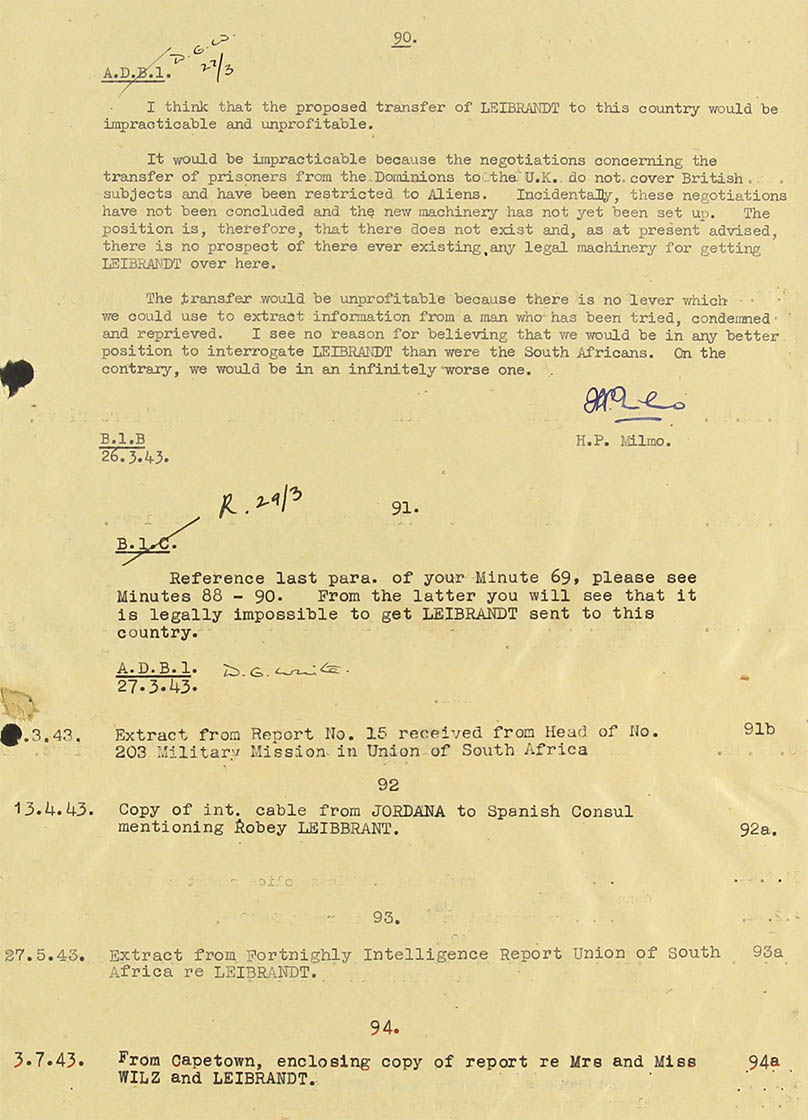
Crown Copyright
A.D.B.1. (Mr. D.G. White M.I.5.)
I think that the proposed transfer of Leibrandt to this country (England) would be impracticable and unprofitable.
It would be impractible because the negotiations concerning the transfer of prisoners from Dominions to the U.K. do not cover British subjects (they apparently do consider that South African citizen being British subjects) and have been restricted to Aliens. Incidentally, these negotiations have not been concluded and the new machinery has not yet been set up. The position is, therefore, that there does not exist and, as at present advised (most likely by the Home Office), there is no prospect of there ever existing legal machinery for getting Leibrandt over here.
The transfer would be unprofitable because there is no lever which we could use to extract information from a man who has been tried, condemned and reprieved. I see no reason for believing that he would be in any better position to interrogate Leibrandt than there were the South Africans. On the contrary, we would be in an infinitely worse one.
B.1.b. (M.I.5.) 26.3.43 Sgd. H.P. Milmo
KV 2/925-1, page 10
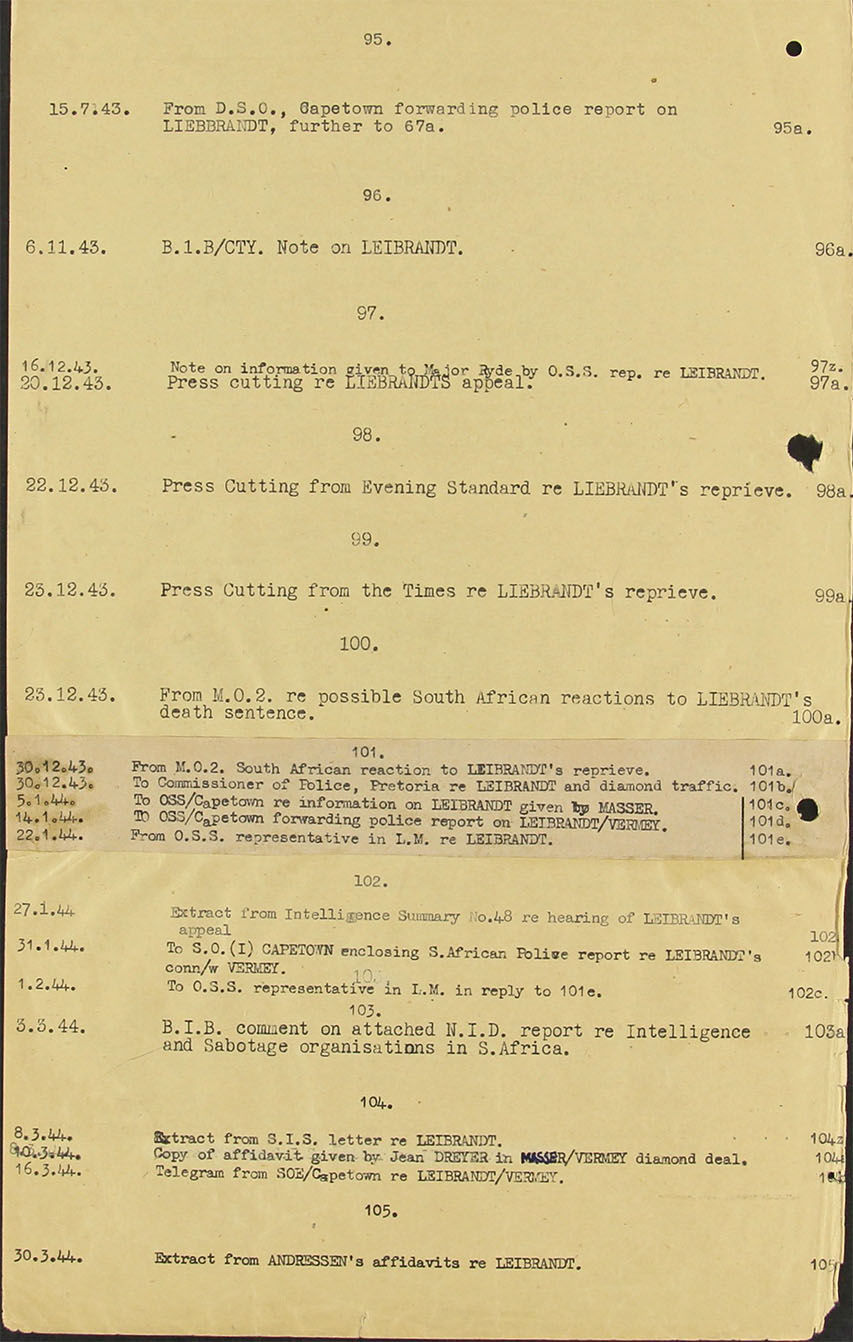
Crown Copyright
..
20.12.43 Press cutting re Leibrandt's appeal (97a)
..
22.12.43 Press cutting from Evening Standard re Leibrandt's reprieve (amnesty).
..
25.12.43 From M.O.2. re possible South African reactions to Leibrandt's death sentence. (AOB: The S.A. Government was quite afraid of the eventual response in this case; therefore I consider that this was the driving consideration to reprieve instead of executing the Death Sentence)
KV 2/925-1, page 12 (starting with minute 112)
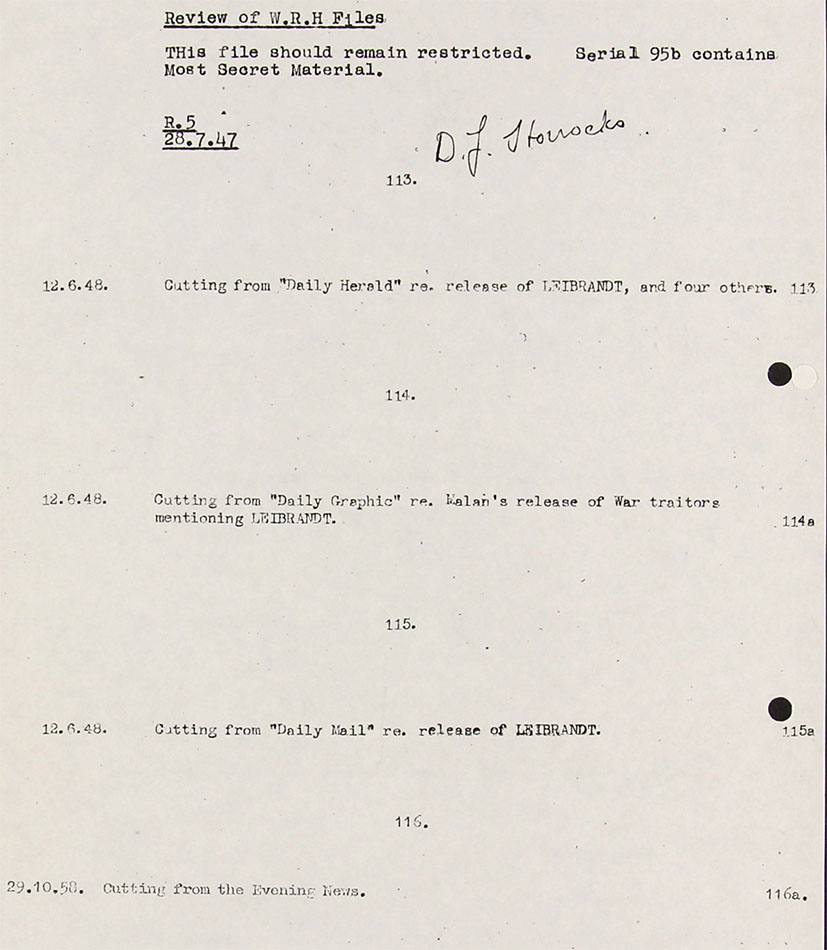
Crown Copyright
Review of W.R.H Files
This file should remain restricted. Serial 95b contains Most Secret Material (M.S.S.; MSS) Apparently already being skipped in the reproduced minute page at page 10 foregoing
R.5 28.7.47
12.6.48 Cutting from "Daily Graphic" re Malan's release of War traitors mentioning Leibrandt (114a)
12.6.48 Cutting from "Daily Mail" re release of Leibrandt ↓ (115a)
29.10.58 Cutting from the Evening News. (116a)
KV 2/925-1, page 13 (minutes 114a + 115a ↑)
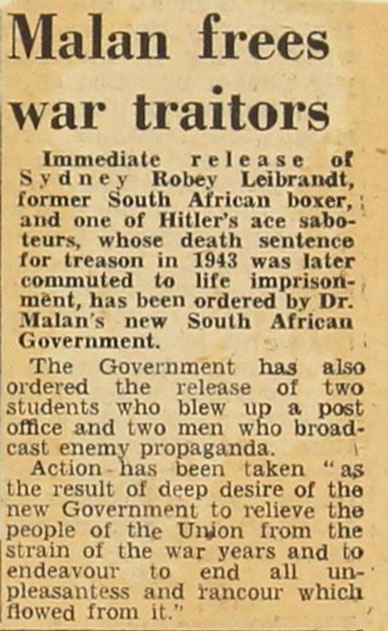
Crown Copyright
Daily Graphic 12 June 1948
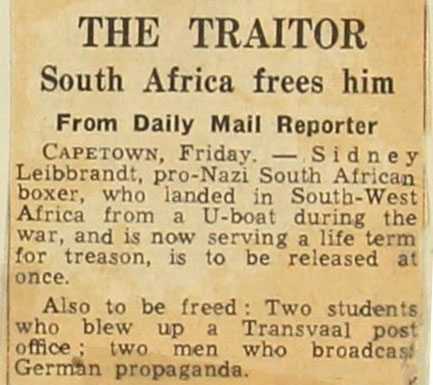
Crown Copyright
Daily Mail 12th June 1948
KV 2/925-2, page 15 (minute 113a)

Crown Copyright
Daily Herald 12th June 1948
Malan Opens Traitor Jails
Robert Leibrandt, the South African Olympic boxer, whom Hitler sent home by
U-boat (German Abwehr controlled sailing boat Kyloe) (D12
D12return) from Germany in 1941-"to organise revolt and
sabotage"- is to be released by the Union's new Nationalist Government from life
imprisonment to which his death sentence was commuted in 1942 (1943).
In announcing the decision to free Leibrandt and four others convicted of treason or sabotage, Mr. C.R. Swart, Minister of Justice, said at Pretoria last night:
"It is the result of the Government's deep desire to relieve people of the Union from the strain of war years, and to try to end all unpleasantness and rancour (animosity) which flowed from it".
Others freed
Also to be set free are Julian David Visser and Hendrik Stephanus van Berk, university students held responsible for the death of a passer-by when a post office was blown up in 1942. Their death sentences were commuted to life terms.
Jan Adriaan Strauss and Michael Johannes Pienaar sentenced last June to three years hard labour for aiding in the broadcast of Germany wartime propaganda from Berlin are the remaining two to be freed.
To be "considered later" is the case of Erich Sydney Holm South African National serving ten years for treason on charges of broadcasting from Germany.
AOB, Please, always notice: that with the exception of the minute sheets, that with increasing PDF KV 2/xxx page numbers you are going backwards in time)
KV 2/925-1, page 16 (minute 111a)
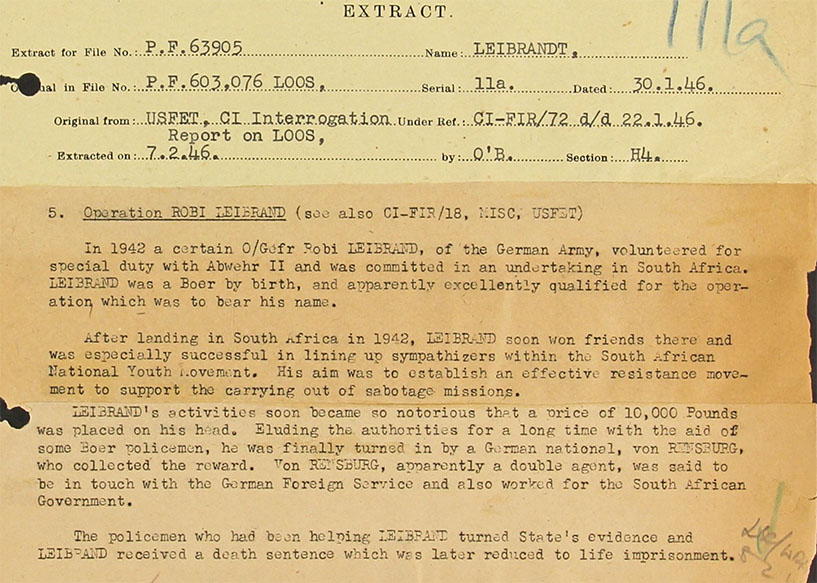
Crown Copyright
Extract
Extract for File No. : PF 63905 Name : Leibrandt
Original in File No : PF 603076 Loos Serial 11a dated : 30.1.46
Original from USFET (United States Forces European Theater), CI (Central Intelligence) Interrogation CI-FIR/72 d/d 22.1.46
5. Operation Robi Leibrand (see also CI-FIR (Final Investigation Report), Misc, USFET)
In 1942 a certain O/Gefr. (Ogfr.)(Obergefreiter) (sergeant) Robi Leibrandt, of the German Army, volunteered for special duty with Abwehr II (sabotage) and was committed in an undertaking in South Africa. Leibrandt was a Boer by birth, and apparently excellently qualified for the operation which was to bear his name.
After landing in South Africa in 1942 (1941),
Leibrandt
soon won friends there and was especially successful in lining up sympathizers
within the South African National Youth Movement. His aim was to establish
an effective resistance movement to support the carrying out of sabotage
missions.
Leibrandt's
activities soon became so notorious that a price of 10,000 Pounds was placed on
his head. eluding the authorities for a long time with the aid of some Boer
policemen, he was finally turned in by a German national, van Rensburg (AOB,
this US report apparently being based upon quite some hear-say,
but incorrect facts)
(van Rensburg was not
a German), who
collected a reward (van
Rensburg wasn't
involved in this at all)
Von Van Rensburg apparently a double agent,
was said to be in touch with the German Foreign Service and also worked for the
South African Government. (He
did neither!)
The policeman who had been helping Leibrandt turned State's evidence and Leibrandt received a death sentence which was later reduced to life imprisonment.
KV 2/925-1, page 18 (minute 110a) E114 ↓↓↓ E114return E115 E115return
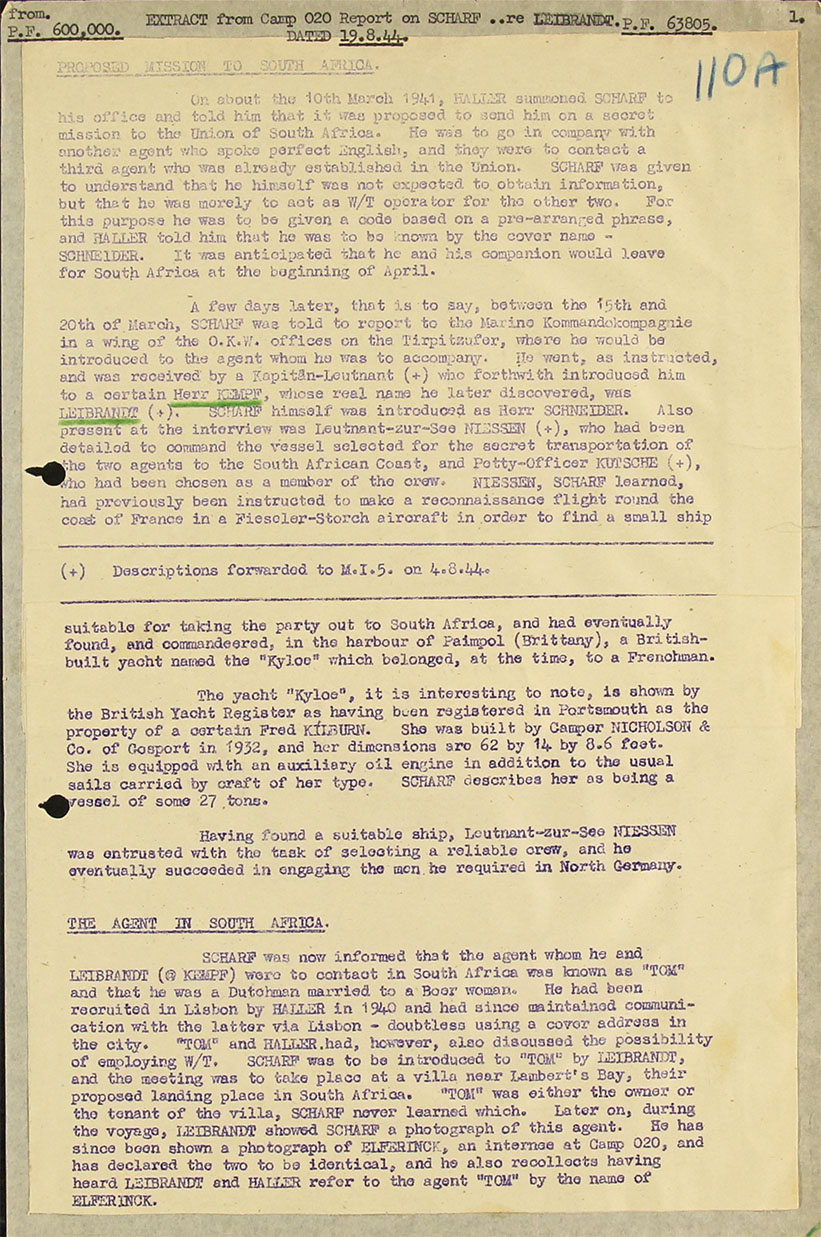
Crown Copyright
from PF 600000 (Hans Karl Scharf, KV 2/207 .. KV 2/209) Extract from Camp 020 report on Scharf re Leibrandt
KV 2/925-1, page 18: KV 2/207 .. KV 2/209 Hans-Karl Scharf about the Kyloe journey.
A few days later, that is to say, between the 15th and 20th of March, Scharf was told to report to the Marine Kommandokompanie in a wing of the OKW offices on the Tirpitzufer (Abwehr HQ), where he would be introduced to the agent whom he was to accompany. He went, as instructed and was received by a Kapitän-Leutnant (Hptm. British Captain) who forthwith introduced him to a certain Herr Kempff whose real name he later discovered, was was Leibrandt. Scharf himself was introduced as Herr Schneider. Also present at the interview was Leutnant-zur-See (Obst.?) Niessen, who had been detailed to command the vessel selected for the secret transportation of the two agents to the South African Coast, and petty-Officer Kutschke who had been chosen as a Member of the crew. Niessen, Scharf learned, had previously been instructed to make reconnaissance flight round the coast of France in a Fieseler-Storch aircraft (Fi-156) on order to find a small ship suitable for taking the party out to south Africa, and had eventually found, and commanded, in the harbour of Paimpol (Brittany), a British built yacht named the “Kyloe” which belonged, at the time, to a Frenchman.
The yacht “Kyloe” it is interesting to note, is shown by the British Yacht register as having been registered in Portsmouth as the property of a certain Fred Kilburn. She was built by Camper Nicholson & Co. of Gosport in 1932, and their dimensions are 62 by 14 by 8.6 feet. She is equipped with an auxiarly oil engine in addition to the usual sails carried by craft of her type. Scharf describes her as being a vessel of some 27 tons.
Having found a suitable ship, Leutnant-zur-See Niessen was entrusted with the task of selecting a reliable crew, and he eventually succeeded in engaging the men he required in North Germany.
The Agent in South Africa.
Scharf was now informed that the agent whom he and Liebrandt (@ Kempf) were to contact in South Africa was known as “Tom” and that and that he was a Dutchman married to a Boer woman. He had been recruited in Lisbon by Haller in 1940 (all cover, but great nonsense) and had since maintained communication with the latter via Lisbon – doubtless using cover address in the city. “Tom” and Haller had, however, also discussed the possibility of employing W/T. Scharf was to be introduced to “Tom”by Leibrandt, and the meeting was to take place at a villa near Lambert’s Bay, their proposed landing place in South Africa. “Tom” was either the owner or the tenant of the villa, Scharf never learned which. later on, during the voyage, Leibrandt showed Scharf a photograph of this agent. He has since been shown a photograph of Elferinck (KV 2/202 PF 65880 Elfrink @ Hamlet page 3 – 4 CX/12799/1257 Puck @ Elferink page 5: 6.9.43 Elfrink joining Dutch Forces), an internee at Camp 020, and has declared the two be identical, and he also recollects having heard Leibrandt and Haller refer to the agent “Tom” by the name of Elfrink → (page 19)
KV 2/925-1, page 19 (minute 110a)
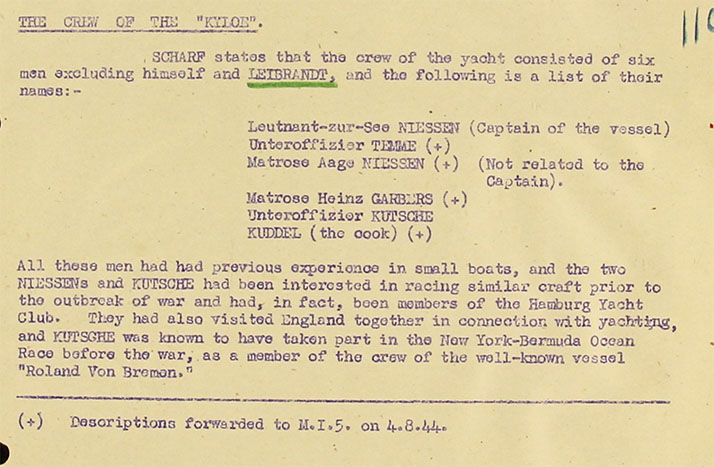
Crown Copyright
The Crew of the Kyloe.
Scharf states that the crew of the yacht consisted of six men excluding himself and Leibrandt, and the following is a list of their names: -
Leutenet-zur-See Niessen (Captain of the vessel)
Uffz. Temme
Matrose Aage Niessen (not related to the Captain)
Matrose Heinz Garbers (the later very successful Captain of the far more successful Passim (Santa Barbara). The latter highly exceptionally received after his second tour to Argentine the highest German decoration the "Ritterkreuz" only three men of the Abwehr ever received such high decoration)
Uffz. Kutsche
Cook Kuddel
All these men had had previous experience in small boats, and the two Niessen's and Kutsche had been interested in the racing similar craft prior to the outbreak of war and had, in fact, been members of the Hamburg Yacht Club. They had also visited England together in connection with yachting, and Kutsche was known to have taken part in the New Yourk-Bermuda Ocean Race before the warm as a member of the crew of the well-know vessel "Roland von Bremen".

The vessel Kiloe
KV 2/925-1, page 20 (minute 110a)
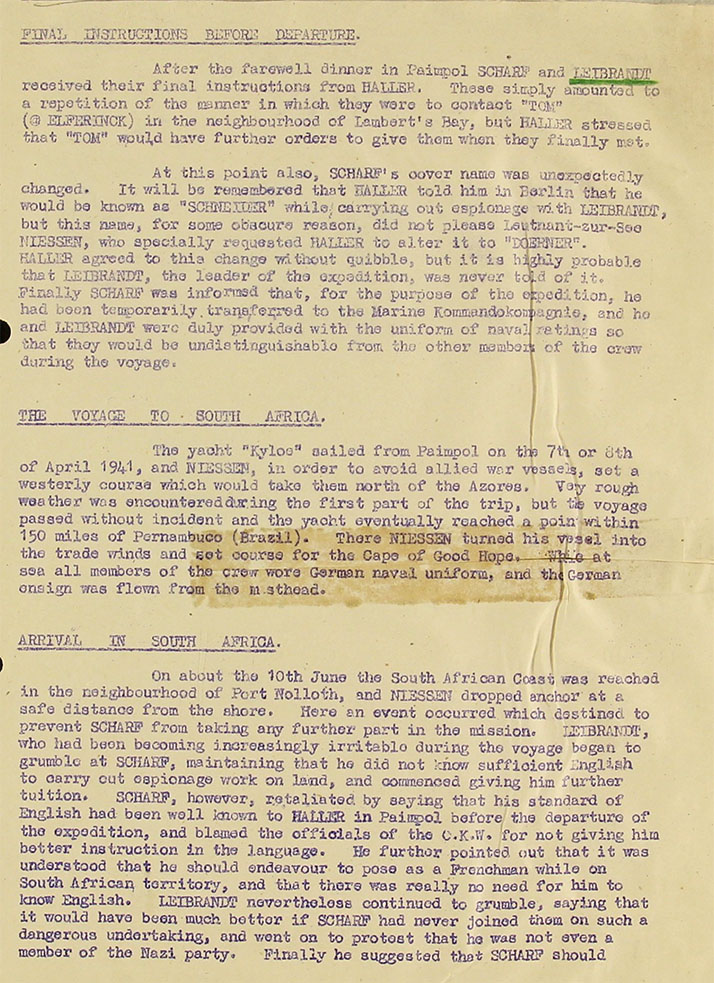
Crown Copyright
continuation of the extract from Camp 020 Report on Scharf re Leibrandt dated 19.8.44
Final Instructions before departure.
After the farewell dinner in Paimpol (Brittany France) Scharf and Leibrandt received their final instructions from Haller. There simply amounted to a repetition of the manner in which they were to contact "Tom" (@ Elfrink) in the neighbourhood of Lambertsbaai, but Haller stressed that "Tom" would have further order to give them when they finally met.
At this point also, Scharf's cover name was unexpectedly changed. It will be remembered that Haller told him in Berlin that he would be known as "Scheider" while carrying out espionage with Leibrandt, but this name, for some obscure reason did not please Leutnant-zur-See Niessen, who specially requested Haller to alter it to "Doerner". Haller agreed to this change without quibble, but it was highly probable that Leibrandt, the leader of the expedition, was never told of it. Finally Scharf was informed that, for the purpose of the expedition, was never told of it. Finally Scharf was informed that, for the purpose of the expedition, he had been temporarily transferred to the Marine Kommmandokompagnie, and he and Leibrandt were duly provided with the uniform of naval ratings so that they would be undistinguishable from the other members of the crew during the voyage.
The Voyage to South Africa.
The yacht "Kyloe" sailed from Paimpol on the 7th or 8th of April 1941, and Niessen in order to avoid allied vessels, set a westerly course which would take them north of the Azores. Very rough weather was encountered the first part of the trip, but the voyage passed without incident and the yacht eventually reached a point within 150 miles of Parnambuco (Brazil). There Niessen turned his vessel into the trade winds and set course for the Cape of Good Hope. While at sea all members of the crew wore German naval uniforms, and the German ensign was flown from the masthead.
Arrival in South Africa.
On about the 10th June the South African Coast was reached in the neighbourhood of port Holloth, and Niessen dropped at a safe distance from the shore. Here an event occurred which destined to prevent Scharf from taking any further part in the mission. Leibrandt, who had been becoming increasingly irritable during the voyage began to grumble at Scharf, maintaining that he did not know sufficient English to carry out espionage work on land, and commenced giving him further tuition. Scharf, however, retaliated by saying that this standard of English had been well known to Haller in Paimpol before the departure of the expedition, and blamed the officials of the O.K.W. for not giving him better instruction in the language. He further pointed out that it was understood that he should endeavour to pose as a Frenchman while on South African territory, and that there was really no need for him to know English. Leibrandt nevertheless continued to grumble, saying that it would have been better if Scharf had never joined them on such a dangerous undertaking, and went on to protest that he was not even a member of the Nazi party. Finally he suggested that Scharf should → (page 21)→return to Germany and become a Party member before considering coming out to South Africa, ..
GoogleEarth
About Lambertsbaai the Kyloe Leibrandt disembarked
KV 2/925-1, page 21
return to Germany and become a Party member before considering coming out to South Africa, and as a result of the proposal the atmosphere on board the yacht became so tense that pistols were drawn by two men and peace was only restored by the intervention of Leutnant-zur-See Niessen (the Captain). Scharf now found himself in a very awkward position, for his instructions were to go ashore at Lambert's Bay with Leibrandt and make contact with "Tom" and Leibrandt flatly refused on his own for his poor knowledge of the English would swiftly have led to his arrest, so he resolved, after careful consideration, to remain on board the "Kyloe" and return with her to Germany (France).
Departure of Leibrandt.
Leibrandt now decided to leave the yacht without delay, and asked Niessen to make arrangements to land him at the first available opportunity. The Captain, therefore, after waiting for nightfall, brought the "Kyloe" to within six or seven kilometres of Port Nolloth, and a small collapsible dinghy (Schlauchboot) was launched. Into this Leibrandt climbed, taking with him his personal suitcase and one of the W/T sets, and he pulled away into the gloom, muttering that "blood would flow in Johannesburg and Pretoria" after his arrival. The landing was carried out on a calm moonlight night, and that was the last that Scharf ever heard of Leibrandt.
KV 2/925-1,page 58 (minute 101a)
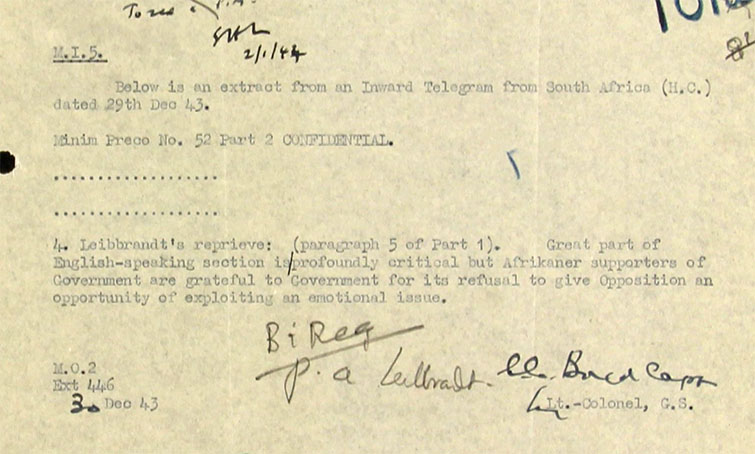
Crown Copyright
M.I.5.
Below is an extract from an iward telegram from South Africa (H.C.) dated 29th Dec. 43
...
4. Leibrandt's reprieve: .... Great part of English-speaking section is profoundly critical but Afrikaner (native) supporters of government are grateful to Government for its refusal to give Oppostion an opportunity of exploiting an emotionally issue.
AOB: just hitting the crucial point!
M.O. 2 3. Dec. 43
KV 2/925-1, page 61 (minute 100a)
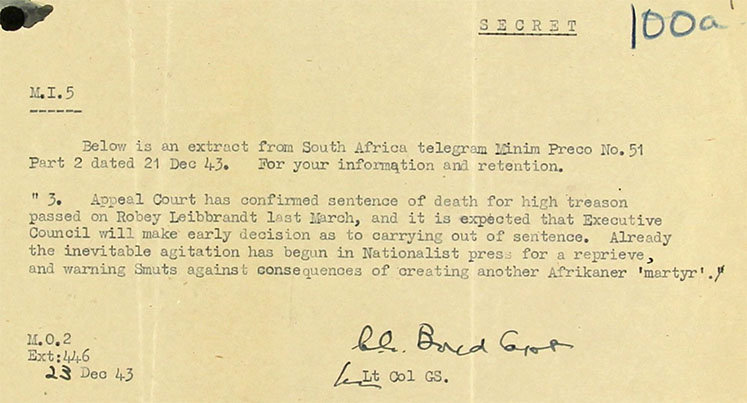
Crown Copyright
M.I.5.
Below is an extract from South African telegram Presco No. 51 Part 2 dated 21 dec 43.
"3. Appeal Court has confirmed sentence of death for high treason passed on Robey Leibrandt last March (1943), and it is expected that Executive Council will make early decision as to carrying out of sentence. Already the inevitable agitation has been in Nationalist press for a retrieve, and warning Smuts against consequences of creating another Afrikaner 'martyr'.
M.O.2 .. 23 Dec 1943
KV 2/925-1, page 62 (minute 99a)
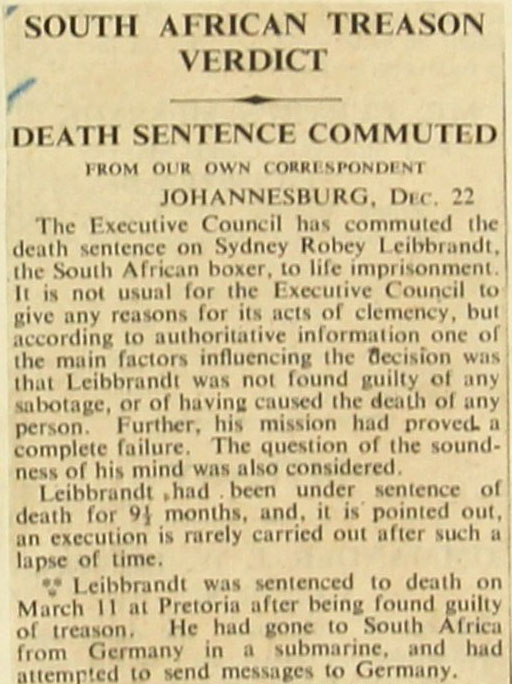
Crown Copyright
Press Cutting
The Times Date 21.12.43
South African Treason Verdict
Death sentence commuted
from our own correspondent
The Executive Council has commuted the death sentence on Sidney Robey Leibrandt, the South African boxer, to life imprisonment. It is not usual for the Executive Council to give any reasons for for its act of clemency, but according to authoriative information one of the main factors influencing the decision was that Leibrandt was not found guilty of any sabotage, or having caused the death of any person. Further, his mission had proved a complete failure. The question of the soundness of his mind was also considered.
Leibrandt had been under sentence of death for 9½ months, and, it is pointed out, an execution is rarely carried out after such a lapse of time.
Leibrandt was sentenced to death on March 11 at Pretoria after being found guilty of treason. he had gone to South Africa from Germany in a submarine (nonsense!) (see: E114 E114return)
KV 2/925-1, page 63 (minute 98a)
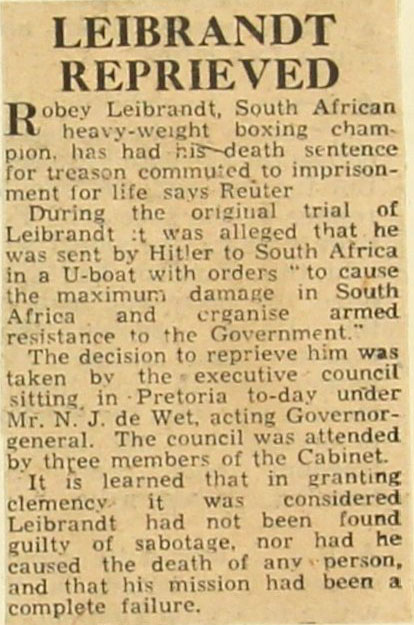
Crown Copyright
Press cutting
Standard Date 22-12'43
Leibrandt
Reprieved
Robey Leibrandt, South African heavy-weight boxing champion has had his death sentence for treason commuted to imprisonment for life says Reuter.
During the original trial of Leibrandt it was alleged that he was sent by Hitler to South Africa in a U-boat (nonsense!) (see E115 E115return) with orders "to cause the maximum damage in South Africa and organise armed resistance to the Government".
The decision to reprieve him was taken by the executive council sitting in Pretoria today under Mr. N.J. de Wet (an Afrikaner name), acting Governor-general. The council was attended by three members of the Cabinet.
It is learned that in granting clemency it was considered Leibrandt had not been found guilty of sabotage, nor had he caused the death of any person, and that his mission had been a complete failure.
KV 2/925-1, page 64 (minute 97a)
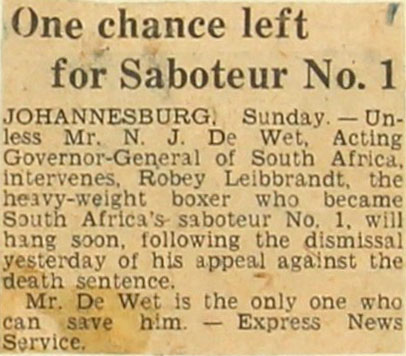
Crown Copyright
From the Press Section (M.I.5.)
Daily Express Date 20-1'2-1943
One chance left
for Saboteur No. 1
Johannesburg. Sunday. - Unless Mr. N.J. de Wet, Acting Governor-General of South Africa, intervenes, Robey Leibrandt, the heavy-weight boxer who became South-African saboteur No. 1, will hang soon, following the dismissal yesterday of his appeal against the death sentence.
Mr. De Wet is the only one who can save him. Express News Service. (AOB, this reporter most likely was the same one whom delivered the text for the Times article shown minute 99a; as he is also is spelling Leibrandt's name incorrectly)
(3)
KV 2/925-2, page 4 (minute 78b?)
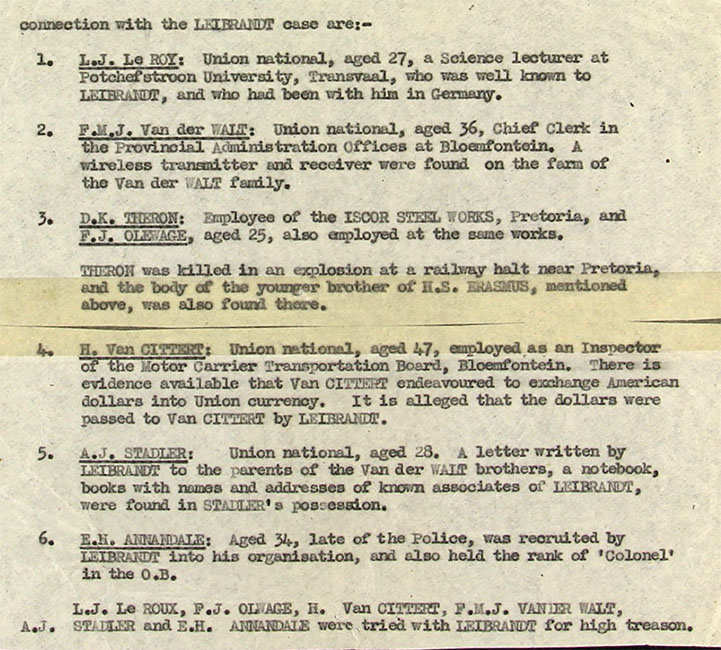
Crown Copyright
connection with the Leibrandt case are:-
1. L.J. Le Roy: Union national, aged 27, a Science lecturer at Potchefstroom University, Transvaal, who was well known to Leibrandt, and who had been with him in Germany.
2. P.M.J. Van der Walt: Union national, aged 36, Chief Clerk in the Provincial Administration Offices at Bloemfontein. A wireless transmitter and receiver were found on the farm of the Van der Walt family.
3. D.K. Theron: Employee of the Iscor Steel Works, Pretoria, and F.J. Olewage, age 25, also employed at the same works.
Theron was killed in an explosion at a railway halt near Pretoria, and the body of the younger brother of H.S. Erasmus, mentioned above, was also found there.
4. H. Van Cittert: Union national, age 47, employed as an Inspector of the Motor Carrier Transportation Board, Bloemfontein. There is evidence available that Van Cittert endeavoured to exchange American dollars into Union currency. It is alleged that the dollars were passed to van Cittert by Leibrandt (whom brought them in from Germany when he re-entered the union of south Africa).
5. A.J. Stadler: Union national, aged 28. A letter written by Leibrandt to the parents of the Van der Walt brothers, a notebook, books with names and addresses of known associated of Leibrandt, were found in Stadler's possession.
6. E.H. Annandale: Aged 34, late of the Police, was recruited by Leibrandt into his organisation, and also held the rank of 'Colonel' in the O.B. (Ossewa Brandwag)
L.J. Le Roux, P.J. Olwage, H. Van Cittert, P.M.J. van der Walt, A.J. Stadler and E.H. Annadale were tried with Leibrandt for high treason.
Now another subject:
G115 ↓↓↓ G115return
KV 2/925-2, page 49 (minute 67?) Again about the W/T gear brought in when Robey Leibrandt had landed ashore, about May 1941; but now also noticing the receiver type he brought-in.
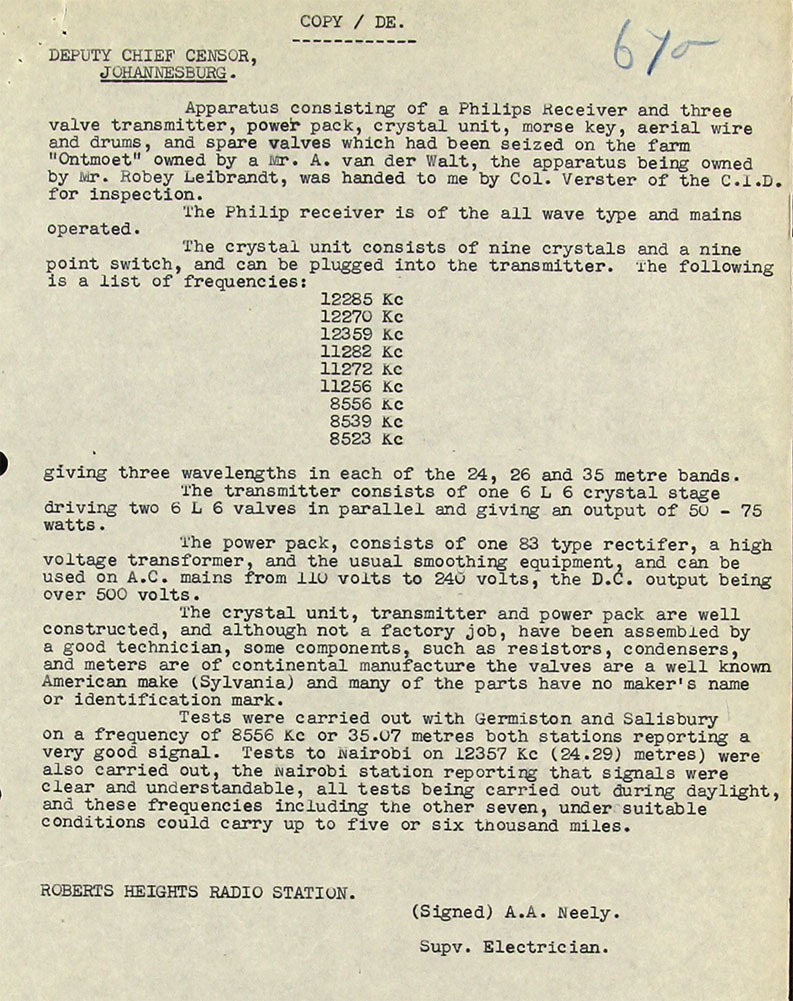
Crown Copyright
Copy / DE.
Deputy Chief Censor, Johannesburg.
Apparatus consisting of a Philips Receiver and three valve transmitter, power pack, crystal unit, morse key, aerial wire and drums, and spare valves which had been seized on the farm "Onmoet" owned by a Mr. A. Walt, the apparatus being owned by Mr. Robey Leibrandt, was handed to me by Col. Verster of the C.I.D. for inspection.
The Philips receiver is of the all wave type and mains operated. (the tiny, but considering its size, very sound functioning and compact (and quite cheap) Philips type "Philetta" U 203 or 204?
The crystal unit consists of nine crystals and a nine point switch, and can be plugged into the transmitter, the following is a list of frequencies:
12285 kHz
12270 kHz
12359 kHz
11282 kHz
11272 kHz
11256 kHz
8556 kHz
8539 kHz
8523 kHz
giving three wavelengths in each of the 24, 26 and 35 metre bands. The transmitter consists of one 6L6 crystal stage driving two 6L6 valves parallel and giving an output of 50 - 75 watts.
The power pack, consists of one 83 type rectifier, a high voltage transformer, and the usual smoothing equipment, and can be used on A.C. mains fro 110 volts to 240 volts, the D.C. output being over 500 volts.
The crystal unit, transmitter and power pack are well constructed, and although not a factory job, have been assembled by a good technician, some components, such as resistors, condensors, and meters are of continental manufacture the valves are well known American made (Sylvania) (AOB, most likely by the Germans purchased via Portugal) and many of the parts have no maker's name or identification mark.
tests were carried out with Germiston and Salisbury on a frequency 8556 kHz or 35.07 metres both stations reporting a very good signal/ Tests to Nairobi on 12357 kHz (24.29) metres) were also carried out, the Nairobi station reporting that the signals were clear and understandable, all test being carried out during daylight (office hours), and these frequencies including the other seven under suitable conditions could carry up to five or six thousand miles.
Robberts Heights Radio Station Sgd. A.A. Neely Supv. Electrician.
KV 2/925-2, page 59 (minute 63a)

Crown Copyright
D.D. 124
No. C.G.S. 2357(L)
Union of South Africa Unie van Suid- Afrika
Headquarters,
Union defence Force
Hoofdkwartier
Unie-Verdedigingsmag,
Pretoria.
10th December, 1941
The Director of Military Intelligence,
M.15. (M.I.5)
London.
Re: Leibrandt - Mrs. Meredith.
I am enclosing, for your information, a copy of a report received by the commissioner of Police, Pretoria from the deputy Commissioner, Witwatersrand Division no. W.D. 10/10/1144/633 of Dec. 4, 1941, and a copy of our G.09771, Dec. 9th referring to your DS/1643/41/B.3.b. of Dec. 3.
Colonel,
D.M.O. & I.
AOB: why have I duplicated this message, directed on to M.I.5. in London?
Because of the spelling on behalf of the South-African Police, of Leibrandt's name:
Leibrandt and not using the, in my perception odd British Leibbrandt; therefore I persist to used the true South African official spelling of: Leibrandt
KV 2/925-2, page 68 (minute 60a)
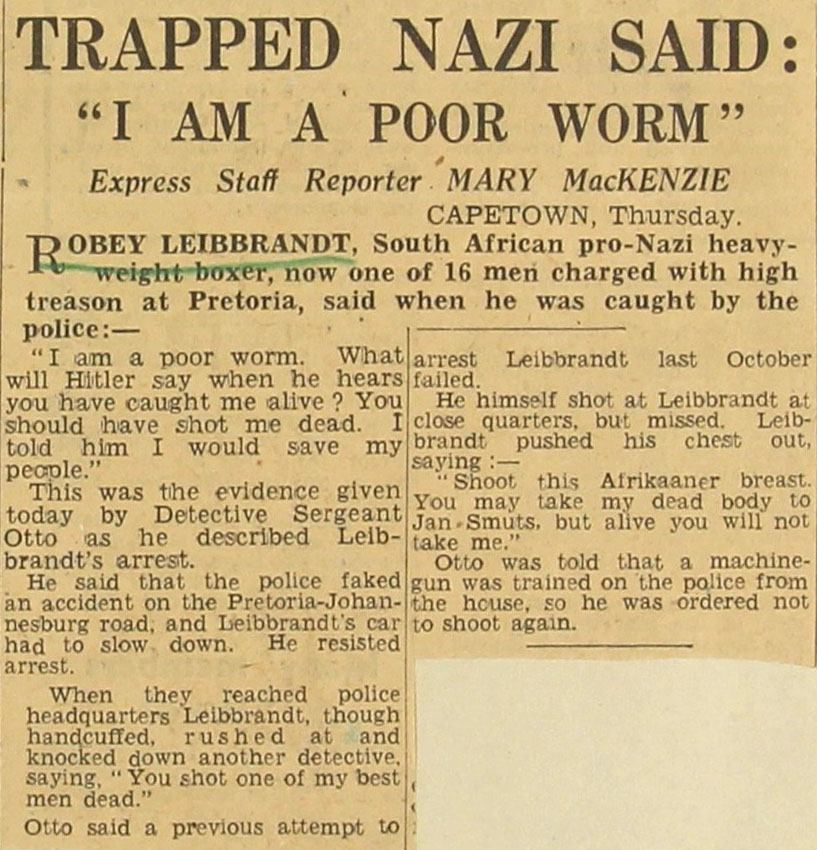
Crown Copyright
Daily Mail Date 27 Mar 1942
Trapped Nazi Said:
"I Am a Poor Worm"
Express Staff reporter Mary MacKenzie
Capetown, Thursday.
Robey Leibrandt, South African pro-Nazi boxer, now one of 16 men charged with high treason at Pretoria, said when he was caught by the police:-
"I am a poor worm. What will Hitler say when he hears you have caught me alive? You should have shot me dead. I told him I would save my people".
This was the evidence given today by detective Sergeant Otto as the described Leibrandt's arrest.
He said the police faked an accident on the Pretoria-Johannesburg road, and Leibrandt's car had to slow down. He resisted arrest.
When they reached police headquarters Leibrandt, though handcuffed, rushed at and knocked down another detective, saying "You shot one of my best men dead".
Otto said a previous attempt to arrest Leibrandt last October failed.
He himself shot at Leibrandt at close quarters, but missed. Leibrandt - pushed his chest out saying:-
"Shoot this Afrikaaner breast. You may take my dead body to Jan Smuts (PM of the South African Union), but alive you will not take me.
Otto was told that a machine-gun was trained on the police from the house he was ordered not to shoot again.
Closure of the Robey Leibrandt file series, due to the lack of further relevant file references.
18 January 2022.
By Arthur O. Bauer